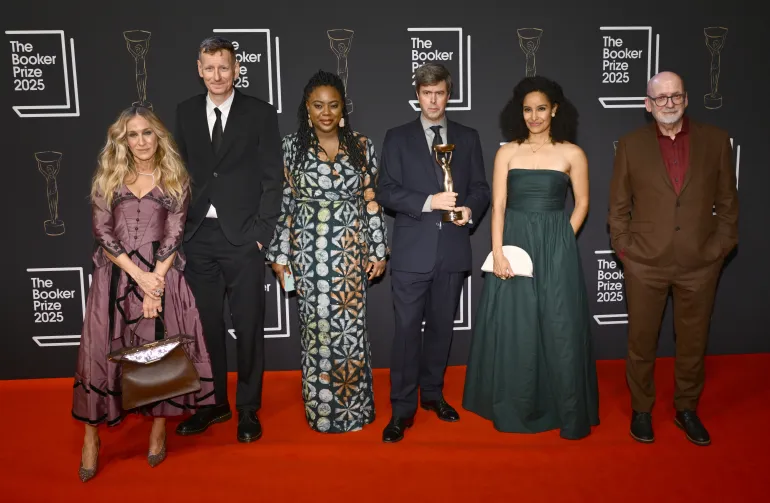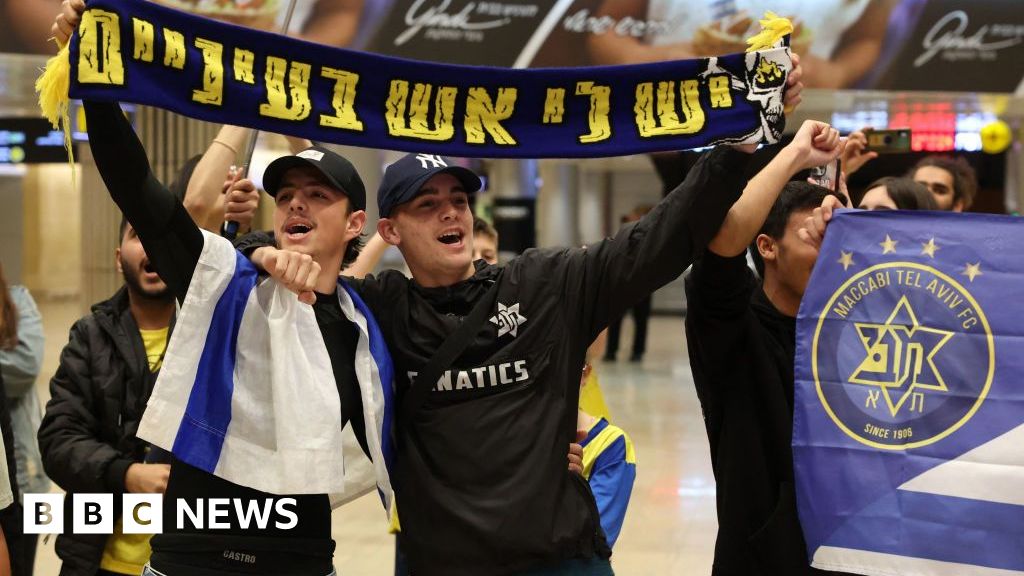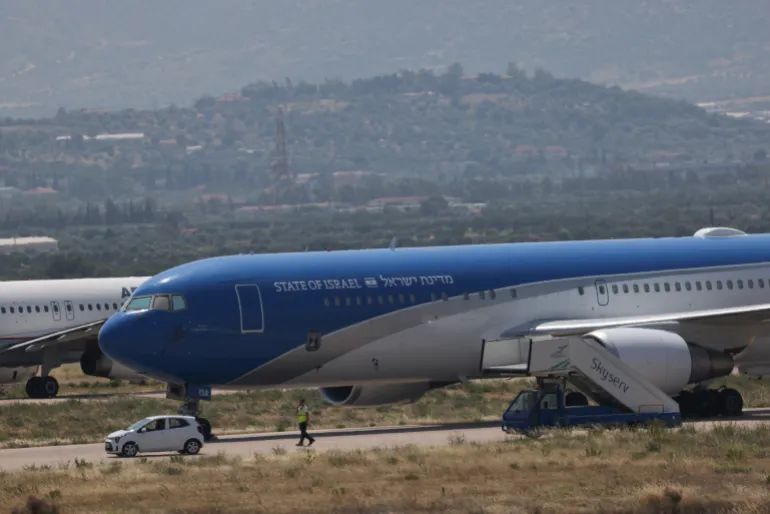Music icon reveals plans to perform at Glastonbury and confirms Rachel Zegler is set to play her in biopic

IT’S hard to believe, but at the age of 68, Gloria Estefan, one of the biggest-selling and most-celebrated artists of all time, is marking her 50th year in music.
She has had a stellar career, racking up everything from a slew of Grammy awards to the Presidential Medal of Freedom.
Sign up for the Showbiz newsletter
Thank you!
But after her musician daughter Emily performed with Cyndi Lauper at Glastonbury last year, she now has one more thing she wants to strike off her bucket list – a major slot on the prestigious Pyramid Stage.
In an exclusive chat, she told Bizarre’s Howell: “It’s very exciting, big and complex from what I hear from Emily. Like, it was crazy. But that would be super exciting.
“If I’m still around, I would love to do that. Now, Glastonbury likes all kinds of artists.”
With hits like Rhythm Is Gonna Get You, Dr Beat and, of course, Conga, she would have plenty of songs to entertain Worthy Farm.
And she may soon be wowing even more viewers, with a big-budget biopic on the cards.
For the first time, she has confirmed Rachel Zegler, who shot to fame in Steven Spielberg’s West Side Story, Disney’s Snow White and recently in Evita on the West End, is set to play her.
She said: “I think she’s awesome. I think she’s incredible. I know she’s killed it in Evita.
“We’re still working on the green light because we’re figuring out where to do it, how to do it.
“This has been in the works for quite a few years now. And that’s how it is. You work, you work, you work, and then all of a sudden, boom, the trigger’s pulled and you’ve got to do it right away. But she’s lovely.”
But asked if she thinks Rachel will take the part, she continued: “I think she would. I just need to offer her an actual part. So we need to be greenlit completely and we’re almost there.
“I met her by Zoom. She’s got a beautiful singing voice and she’s a great actor. So absolutely.”
It was originally claimed the film will be an adaptation of her 2015 jukebox musical On Your Feet! although that idea has changed.
The star explained: “The movie’s not going to be the show. There’s a lot in there.”
Gloria was born in Cuba but her family fled to the US during the Cuban Revolution and she has now become one of Miami’s most famous residents.
And as one of the city’s stars, she has become pals with David and Victoria Beckham, who have a home there and have become key to the area with Becks’ football team Inter Miami CF.
But it’s clear they all move in the upper echelons when Stateside.
In a major name drop when quizzed on hanging out with them, she said: “I’ve been at their home. It’s lovely. David is such a lovely man – and Victoria.
“We actually went to a dinner at their home and President Obama was there, and the head of Reddit, and Jeff Bezos. It was really cool.
“It was small, but only the most powerful people in that room. It was great.
“They’re very kind people. And he’s done amazing things for soccer or football, as you call it here.”
And there have been more Brits in Miami, with Dua Lipa performing there last month, when she covered Gloria’s 1985 hit Conga.
“I was so sad that I wasn’t in town,” Gloria said.
“She had invited me to go and do that with her. And I love her. I’m a big fan of Dua Lipa. And that’s the sexiest conga you’re ever going to see, hands down.”
After such an illustrious career, she recently released her 30th album Raíces, which is largely Spanish-language escapism and the perfect soundtrack for a soiree or relaxing evening in.
And it was her husband of 47 years, producer Emilio, who made it happen.
Gloria, who was writing another musical at the time, explained how the salsa record poured out of him.
She added: “It’s got beautiful, romantic ballads. Emilio said, ‘I wrote you a love song’. I go, ‘Babe, you’re going to sing it?’.
He goes, ‘No, you’re going to sing it for me’.”
Charming.
And as for retirement after five decades in the game? Don’t count on it.
She giggled: “In ten years time, I hope to still be alive. That’s my first plan. Who knows?
“I only choose what I really, really want to give my time to. It’s just that. I had all these amazing opportunities. And they just converged this year.”
Kristen chilled Water
KRISTEN STEWART didn’t let the falling temperatures bother her as she headed out in this white mini-dress.
The Twilight actress showed off a stark fringe and bare legs as she left a screening of her new film The Chronology Of Water at the Curzon Mayfair on Thursday night.
It was part of the BFI London Film Festival and the movie, an adaptation of US writer Lidia Yuknavitch’s memoir, is her directorial debut.
Lily ‘cheat’ pain
LILY ALLEN has confirmed my story that she is about to make a return with her fifth album.
And on it, she seemingly accuses ex-husband David Harbour of cheating on her.
The Smile singer married the Stranger Things actor in 2020.
But things crumbled last year, with the relationship inspiring the latest record which is expected to be released imminently.
A new interview with Lily came out in Vogue magazine yesterday.
It features lyrics from two tracks that suggest David romanced other women while they were together and the pair then decided to “open” their marriage.
On one song, Sleepwalking, Lily sings: “You let me think it was me in my head, and nothing to do with them girls in your bed.”
On another, called Dallas Major, she reveals: “You know I used to be quite famous, that was way back in the day.
“I probably should explain how my marriage has been open since my husband went astray.”
And Lily didn’t hold back in her interview, either.
She told the magazine: “I’ve had real problems with my food over the past few years.
She added that during their break-up “it got really, really, really bad”.
Lily, who is sober, said: “The feelings of despair that I was experiencing were so strong.
“The last time I felt anything like that, drugs and alcohol were my way out, so it was excruciating to sit with those [feelings] and not use them.”
KYLIE JENNER says being a pop star is her lifelong dream – despite being mocked this week when she sang on Terror JR’s new song Fourth Strike.
Having just started singing under the name King Kylie, she said: “You know this is my dream. I’ve been talking about this since I came out of the womb… that like I wanted to be a pop star.
“I just never had the confidence or… I think turning 28 just does something to you. Like I’m going to be 30 soon and I don’t want to look back on life and have any regrets.
“This is something I’ve always wanted to try.”
JENNIFER LOPEZ is up for returning to the Super Bowl stage in February – six years after her stellar half-time show with Shakira.
The singer, whose parents are from Puerto Rico, waved the country’s flag during her performance and next year will see rapper Bad Bunny, who is from there, playing the show.
Quizzed on US TV whether they could do something together there, she said there had been “no talk” of a collaboration but that she would be open to it.
She said: “There’s no talk. I have not gotten any calls. So I just want to put the expectation down. But of course if he wanted me to do something, I would definitely do it.”
Crouchy Enter the Dragon
ABBEY CLANCY and Peter Crouch are slowly turning their home into a zoo – and the next animal they are adding is a bearded dragon.
The couple, who live in Surrey with their four children, already own two dogs, cats and a horse but now they are adding reptiles to the menagerie.
Crouchy says they are getting the reptile, which is native to Australia, because their son is desperate for one as a pet.
As well as the lizard, Abbey wants to also get lambs and chickens.
Peter said: “The more animals the better, apparently. Bearded dragons are next on the horizon. My little boy has wanted one for years. They’re actually all right. I thought it would be a nightmare, but I’ve been down the shop and held them.
“We’re actually going to get one. They grow to be quite big but they’re quite chilled.”
Michael makes big money
MICHAEL McINTYRE’s firm raked in more than £3.2million last year – making him one of the biggest earners on TV.
He had another stellar year presenting Saturday-night series Michael McIntyre’s Big Show and quiz The Wheel.
The comedian’s TV production firm Hungry McBear paid £805,000 in corporation tax in its last financial year up to December 31.
That rate suggests he made just over £3.2million.
Reserves in the company now stand at £1,718,407.
The firm is jointly controlled by Michael and TV producer Dan Baldwin, who is married to Holly Willoughby.
It makes all of Michael’s shows, including Christmas and Easter one-offs and Michael McIntyre: Showman for Netflix.
But the cash doesn’t include earnings from his stand-up tour, so he will be raking in even more.
Autoliv (ALV) Q3 2025 Earnings Call Transcript

Image source: The Motley Fool.
Date
Friday, Oct. 17, 2025, at 8 a.m. ET
Call participants
- President & Chief Executive Officer — Mikael Bratt
- Chief Financial Officer — Fredrik Westin
- Vice President, Investor Relations — Anders Trapp
Need a quote from a Motley Fool analyst? Email [email protected]
Risks
- Regional Production Mix — Adjusted operating margin was negatively impacted by a 20 basis point dilution in Q3 2025, due to not-yet-recovered tariffs and the partial recovery of tariff compensations.
- Engineering Income Decline — “We expect higher depreciation costs due to new manufacturing capacity to meet demand in the key regions, and that the temporary decline in engineering income will persist, driven by the timing of specific customer development projects,” said CEO Mikael Bratt.
- European OEM Production Stoppages — “We continue to see downside risks for Europe’s light vehicle production, driven by announced production stoppage at several key customers,” explained Bratt.
Takeaways
- Net Sales — $2.7 billion, up 6% year-over-year, with organic sales growth of 4% excluding currency effects and including tariff compensation.
- Adjusted Operating Income — $271 million, up 14% year-over-year, with a 10.0% adjusted operating margin, 70 basis points above last year.
- Gross Margin — 19.3%, an increase of 130 basis points year-over-year, primarily driven by improved direct labor efficiency, headcount reductions, and supplier compensation.
- Operating Cash Flow — $258 million in operating cash flow, representing a 46% increase, supported by higher net income and a net $53 million negative impact from working capital.
- Free Operating Cash Flow — $153 million in Q3 2025 compared to $32 million in Q3 2024, due to higher operating cash flow and a $40 million reduction in net capital expenditures.
- Adjusted EPS — Diluted adjusted earnings per share increased 26% or $0.48, mainly from $0.29 higher operating income, $0.09 taxes, and $0.08 lower share count.
- Shareholder Returns — Dividend raised to $0.85 per share; $100 million in share repurchases completed, with 0.8 million shares retired.
- China Performance — Sales to Chinese domestic OEMs grew by nearly 23%, outpacing their light vehicle production growth by 8%.
- India Performance — India contributed one-third of global organic growth, now representing 5% of total sales, with content per vehicle rising from $120 in 2024 to $140 in 2025.
- Tariff Compensation — 75% of tariff costs recovered; remainder expected to be compensated by year-end.
- Capital Expenditures — CapEx net was 3.9% of sales, down from 5.7% in Q3 2024, with company guidance now at 4.5% for the full year 2025.
- Leverage Ratio — Net leverage at 1.3 times, maintained below the 1.5 times target.
- Strategic Initiatives — New second R&D center in China, partnership with CATARC, and a joint venture with HSAE to produce advanced safety electronics announced.
- Outlook and Guidance — Organic sales projected to increase by ~3% and adjusted operating margin expected at 10%-10.5% for full-year 2025; operating cash flow guidance of ~$1.2 billion; tax rate forecasted at ~28%.
Summary
Autoliv (ALV -2.72%) delivered record net sales and adjusted operating income in Q3 2025, reflecting successful execution of efficiency initiatives. Management confirmed transactions to deepen presence in China and cited the joint venture with HSAE as an entry into advanced automotive safety electronics. Working capital increased by $197 million in Q3 2025 compared to Q3 2024, mainly due to higher accounts receivable from strong sales and delayed tariff reimbursements, which management described as temporary effects. The company achieved a 94% coil-off accuracy rate in Q3 2025, highlighting this improvement as a significant contributor to its operational targets. Light vehicle production outperformed the market, driven by strong organic momentum in India and among Chinese OEMs, although negative regional and customer mixes offset some gains in Q3 2025.
- Chief Financial Officer Fredrik Westin said, “The $50 million there is a one-time, and it is compensation from a supplier for historical costs that we had versus our customers there. It is one time in the quarter here, for previous costs that we have had.”
- Management noted, “we expect to be in the middle of the range” for full-year 2025 adjusted operating margin guidance, after citing headwinds from lower out-of-period inflation compensation, higher depreciation, and temporary engineering income declines heading into the fourth quarter.
- CEO Mikael Bratt stated, “Expanding in China is key to strengthening Autoliv’s innovation, global competitiveness, and long-term growth,” underlining China as a principal driver of strategy and resource allocation.
- The shift toward normalized capital expenditures follows the completion of large-scale, multi-region footprint investments over recent years, enabling lower capital intensity moving forward.
Industry glossary
- Coil-off Accuracy: Percentage metric tracking adherence of parts inventory depletion to schedule, reflecting production planning effectiveness and supply chain reliability.
- OEM: Original Equipment Manufacturer; refers here to carmakers that buy Autoliv’s safety products for installation in new vehicles.
- ECU: Electronic Control Unit, a core component in automotive electronics, governing safety features like active seatbelts and detection systems.
- RD&E: Research, Development & Engineering expenses, comprising spending on new products, process improvement, and engineering-driven customer projects.
- CapEx: Capital expenditures, defined as spending on property, plant, and equipment.
Full Conference Call Transcript
Operator: Good day, and thank you for standing by. Welcome to the Autoliv, Inc. third quarter 2025 financial results conference call and webcast. (Operator Instructions) Please note that today’s conference is being recorded. I would now like to turn the conference over to your first speaker, Anders Trapp, Vice President of Investor Relations.
Please go ahead.
Anders Trapp: Thank you, Lars. Welcome, everyone, to our third quarter 2025 earnings call. On this call, we have our President and Chief Executive Officer, Mikael Bratt; our Chief Financial Officer, Fredrik Westin; and me Anders Trapp, VP, Investor Relations. During today’s earnings call, we will highlight several key areas, including our record-breaking third quarter sales and earnings, as well as our continued strategic investments to drive long-term success with Chinese OEMs. We also provide an update on market developments and the evolving tariff landscape impacting the automotive industry.
Finally, our robust balance sheet and strong asset returns reinforce our financial resilience and support sustained high levels of shareholder returns. Following the presentation, we will be available to answer your questions. And as usual, the slides are available at autoliv.com.
Turning to the next slide, we have the Safe Harbor Statement, which is an integrated part of this presentation and includes the Q&A that follows. During the presentation, we will reference some non-U.S. GAAP measures. The reconciliations of historical U.S. GAAP and non-U.S. GAAP measures are disclosed in our quarterly earnings release available on autoliv.com and in the 10-Q that will be filed with the SEC or at the end of this presentation. Lastly, I should mention that this call is intended to conclude with a reach CET, so please wait for your questions in person. I now hand it over to our CEO, Mikael Bratt.
Mikael Bratt: Thank you, Anders. Looking on the next slide, I am pleased to share yet another record-breaking quarter, underscoring our strong market position. This success is a testament to the strength of our customer relationships and our commitment to continuous improvement as we navigate the complexities of tariffs and other challenging economic factors. We saw a significant sales growth driven by higher-than-expected light vehicle production across multiple regions, especially in China and North America. Our high growth in India continues, accounting for one-third of our global organic growth. I am pleased to highlight that our sales growth with Chinese OEMs has returned to outperformance, driven by recent product launches and encouraging development.
Looking ahead, we anticipate to significantly outperform light vehicle production in China during the fourth quarter. We improved our operating profit and operating margin compared to a year ago. This strong performance was primarily driven by well-executed activities to improve efficiency, higher sales, and a supplier compensation for an earlier recall. We successfully recovered approximately 75% of the tariff costs incurred during the third quarter and expect to recover most of the remaining portions of existing tariffs later this year. The combination of not-yet-recovered tariffs and the dilutive effects of the recovered portion resulted in a negative impact of approximately 20 basis points on our operating margin in the quarter.
We also achieved record earnings per share for the third quarter. Over the past five years, we have more than tripled our earnings per share, mainly driven by strong net profit growth but also supported by a reduced share count. Our cash flow remained robust despite higher receivables driven by higher sales and tariff compensations later in the quarter. Our solid performance, combined with a healthy debt level ratio, supports continuous strong shareholder returns. We remain committed to our ambition of achieving $300 to $500 million annual in stock repurchases, as outlined during our Capital Markets Day in June.
Additionally, we have increased our quarter dividend to $0.85 per share, reflecting our confidence in our continued financial strength and long-term value creation. Expanding in China is key to strengthening Autoliv’s innovation, global competitiveness, and long-term growth. To support our growing partnerships with Chinese OEMs, we are investing in a second R&D center in China. In October, we announced a new important collaboration in China, as illustrated on the next slide. We have signed a strategic agreement with CATARC, the leading research institution setting standards in the Chinese automotive sector. This partnership marks a new chapter in our commitment to shaping the future of automotive safety.
Together with CATARC, we aim to define the next generation of safety standards and enhance the safety on the roads in China and globally. We are also broadening our reach in automotive safety electronics, as shown on the next slide. We recently announced our plans to form a joint venture with HSAE, a leading Chinese automotive electronics developer, to develop and manufacture advanced safety electronics. The joint venture will concentrate on high-growth areas in advanced safety electronics, including ECUs for active seatbelts, hands-on detection systems for steering wheels, and the development and production of steering wheel switches.
Through this new joint venture, we intend to capture more value from steering wheels and active seatbelts while minimizing CapEx and competence expansions, enabling faster market entry with lower technology and execution risks. Looking now on financials in more detail on the next slide. Third quarter sales increased by 6% year-over-year, driven by strong outperformance relative to light vehicle production in Asia and South America, along with favorable currency effects and tariff-related compensations. This growth was partly offset by an unfavorable regional and customer mix. The adjusted operating income for Q3 increased by 14% to $271 million, from $237 million last year. The adjusted operating margin was 10%, 70 basis points better than in the same quarter last year.
Operating cash flow was a solid $258 million, an increase of $81 million, or 46% compared to last year. Looking now on the next slide, we continue to deliver broad-based improvements, with particularly strong progress in direct costs and SG&A expenses. Our positive direct labor productivity trend continues as we reduced our direct production personnel by 1,900 year-over-year. This is supported by the implementation of our strategic initiatives, including automation and digitalization. Our gross margin was 19.3%, an increase of 130 basis points year-over-year. The improvement was mainly the result of direct labor efficiency, headcount reductions, and compensation from a supplier.
Our G&E net costs rose both sequentially and year-over-year, primarily due to lower engineering income due to timing of specific customer development projects. Thanks to our cost-saving initiatives, SG&A expenses decreased from the first half-year level. Combined with the increased gross margin, this led to 70 basis points improvement in adjusted operating margin. Looking now on the market developments in the third quarter on the next slide. According to S&P Global data from October, global light vehicle production for the third quarter increased 4.6%, exceeding the expectations from the beginning of the quarter by 4 percentage points. Supported by the scrapping and replacement subsidy policy, we continue to see strong growth for domestic OEMs in China.
Light vehicle demand and production in North America have proven significantly more resilient than previously anticipated. In contrast, light vehicle production in other high-content-per-vehicle markets, namely Western Europe and Japan, declined by approximately 2% to 3%, respectively. The global regional light vehicle production mix was approximately 1 percentage point unfavorable during the quarter, despite the important North American market showing a positive trend. In the quarter, we did see coil-off volatility continue to improve year-over-year and sequentially from the first half-year. The industry may experience increased volatility in the fourth quarter, stemming from a recent fire incident at an aluminum production plant in North America and production adjustments by a key European customer in response to shifting demand.
We will talk about the market development more in detail later in the presentation. Looking now on sales growth in more detail on the next slide. Our consolidated net sales were over $2.7 billion, the highest for the third quarter so far. This was around $150 million higher than last year, driven by price volume, positive currency translation effects, and $14 million from tariff-related compensations. Excluding currencies, our organic sales growth by 4%, including tariff costs and compensations. China accounted for 90% of our group sales. Asia, excluding China, accounted for 20%. Americas for 33%, and Europe for around 28%. We outline our organic sales growth compared to light vehicle production on the next slide.
Our quarterly sales were robust and exceeded our expectations, driven by strong performance across most regions, particularly in the Americas, West Asia, and China. Based on light vehicle production data from October, we underperformed light vehicle production by 0.7% globally, as a result of a negative regional mix of 1.3%. We underperformed slightly in Europe, primarily due to an unfavorable model and customer mix. In the rest of Asia, we outperformed the market with 8%, driven primarily by strong sales growth in India and, to a lesser extent, in South Korea.
While the organic light vehicle production mix shifts continued to impact our overall performance in China, our sales to domestic OEMs grew by almost 23%, 8% more than their light vehicle production growth. Our sales development with the global customers in China was 5% lower than their light vehicle production development, as our sales declined to some key customers, such as Volkswagen, Toyota, and Mercedes. On the next slide, we show some key model launches. The third quarter of 2025 went through a high number of new launches, primarily in Asia, including China. Although some of these new launches in China remained undisclosed here due to confidentiality, the new launches reflect a strong momentum for Autoliv in these important markets.
The models displayed here feature Autoliv content per vehicle from $150 to close to $400. We’re also pleased to have launched airbags and seatbelts on another small Japanese vehicle, A-Cars. This is a meaningful forward step because Autoliv has historically had limited exposure to this segment in Japan. In terms of Autoliv’s sales potential, the Onvo L90 is the most significant. Higher content per vehicle is driven by front center airbags on five of these vehicles. Now looking at the next slide, I will now hand it over to Fredrik Westin.
Fredrik Westin: Thank you, Mikael. I will talk about the financials more in detail now on the slides, so turn to the next slide. This slide highlights our key figures for the third quarter of 2025 compared to the third quarter of 2024. The net sales were approximately $2.7 billion, representing a 6% increase. The gross profit increased by $63 million, and the gross margin increased by 130 basis points. The drivers behind the gross profit improvement were mainly lower material costs, positive effects from the higher sales, and improved operational efficiency. This was partly offset by negative effects from recalls and warranty, depreciation, and unrecovered tariff costs.
The adjusted operating income increased from $237 million to $271 million, and the adjusted operating margin increased by 70 basis points to 10.0%. The reported operating income of $267 million was $4 million lower than the adjusted operating income.
Adjusted earnings per share diluted increased 26% or by $0.48, where the main drivers were $0.29 from higher operating income, $0.09 from taxes, and $0.08 from a lower number of shares. This marks our ninth consecutive quarter of growth in adjusted earnings per share, underscoring the strength of our ongoing operational improvements and further bolstered by a reduced share count from our share buyback program. Our adjusted return on capital employed was a solid 25.5%, and our adjusted return on equity was 28.3%. We paid a dividend of $0.85 per share in the quarter, and we repurchased shares for $100 million and retired 0.8 million shares. Looking now on the adjusted operating income bridge on the next slide.
In the third quarter of 2025, our adjusted operating income increased by $34 million.
Operations contributed with $43 million, mainly from high organic sales and from the execution of operational improvement plans supported by better coil-off volatility. The out-of-period cost compensation was $8 million lower than last year. Costs for RD&E net and SG&A increased by $30 million, mainly due to lower engineering income. The net currency effect was $6 million positive, mainly from translation effects. Last year’s supplier settlement and this year’s supplier compensation combined had a $29 million positive impact. The combination of unrecovered tariffs and the dilutive effect of the recovered portion resulted in a negative impact of approximately 20 basis points on our operating margin in the quarter. Looking now at the cash flow on the next slide.
The operating cash flow for the third quarter of 2025 totaled $258 million, an increase of $81 million compared to the same period last year, mainly as a result of higher net income, partly offset by $53 million negative working capital effects. The negative working capital was primarily driven by higher receivables, reflecting strong sales and delayed tariff compensations toward the end of the quarter. Capital expenditures net decreased by $40 million. Capital expenditures net in relation to sales was 3.9% versus 5.7% a year earlier. The lower level of capital expenditures net is mainly related to lower footprint CapEx in Europe and Americas and less capacity expansion in Asia.
The free operating cash flow was $153 million compared to $32 million in the same period the prior year from higher operating cash flow and the lower CapEx net.
The cash conversion in the quarter, defined as free operating cash flow in relation to the net income, was around 87%, in line with our target of at least 80%. Now looking at our trade working capital development on the next slide. The trade working capital increased by $197 million compared to the prior year, where the main drivers were $165 million in higher accounts receivables, $8 million in higher accounts payables, and $40 million in higher inventories. The increase in trade working capital is mainly due to increased sales and temporarily higher inventories. In relation to sales, the trade working capital increased from 12.8% to 13.9%.
We view the increase in trade working capital as temporary, as our multi-year improvement program continues to deliver results. Additionally, enhanced customer coil-off accuracy should enable a more efficient inventory management. Now looking at our debt leverage ratio development on the next slide.
Autoliv’s balanced leverage strategy reflects our prudent financial management, enabling resilience, innovation, and sustained stakeholder value over time. The leverage ratio remains low at 1.3 times, below our target limit of 1.5 times, and has remained stable compared to both the end of the second quarter and the same period last year. This comes despite returning $530 million to shareholders over the past 12 months. Our net debt increased by $20 million, and the 12 months trailing adjusted EBITDA was $41 million higher in the quarter. With that, I hand it back to you, Mikael.
Mikael Bratt: Thank you, Fredrik. On to the next slide. The outlook for the global auto industry has improved, particularly for North America and China.
While the industry continues to navigate the trade volatility and other regional dynamics, S&P now forecasts global light vehicle production to grow by 2% in 2025, following growth of over 4% in the first nine months of the year. Their outlook for the fourth quarter has significantly improved. Nevertheless, they still anticipate a decline in light vehicle production of approximately 2.7% in the quarter. In North America, the outlook for light vehicle production has been significantly upgraded, driven by resilient demand and low new vehicle inventories. However, a recent fire incident at an aluminum production plant in North America may impact our customers.
For Europe, S&P forecasts a 1.8% decline in light vehicle production for the fourth quarter, despite some easing of U.S. import tariffs. We continue to see downside risks for Europe’s light vehicle production, driven by announced production stoppage at several key customers.
In China, light vehicle production is expected to decline by 5%, primarily due to an exceptionally strong Q4 in 2024. Nevertheless, S&P anticipates sustained growth in Chinese LVP over the medium term, supported by favorable government policies for new energy vehicles, more relaxed auto loan regulations, and increasing export volumes. The outlook for Japan’s light vehicle production has improved, as car makers are increasingly shifting exports to markets outside the U.S., aiming to mitigate reduced export volumes to the U.S. In South Korea, domestic demand has been steadily recovering, while exports have also risen, driven by increased shipments to other regions, compensating for the decline in exports to the U.S. Now looking on our way forward on the next slide.
We expect the fourth quarter of 2025 to be challenging for the automotive industry, with lower light vehicle production and geopolitical challenges.
However, our continued focus on efficiency should help offset some of these headwinds. Consistent with typical seasonal patterns, the fourth quarter is expected to be the strongest of the year. Despite the expected decline in global light vehicle production year-over-year, we foresee higher sales and continued outperformance, particularly in China. Unfortunately, we are also facing some year-over-year headwinds. Unlike the past three years, we do not expect out-of-period inflation compensation in the fourth quarter, given the shift in the inflationary environment. We expect higher depreciation costs due to new manufacturing capacity to meet demand in the key regions, and that the temporary decline in engineering income will persist, driven by the timing of specific customer development projects.
These factors combine in the reason for why we currently expect the full-year adjusted operating margin to come in at the midpoint of the guided range.
However, our solid cash conversion and balance sheet provide fast expansions and a robust foundation for maintaining high shareholder returns. Turning to the next slide. This slide shows our full-year 2025 guidance, which excludes effects from capacity alignment and antitrust-related matters. It is based on no material changes to tariffs or trade restrictions that are in effect as part of 2025, as well as no significant changes in the macroeconomic environment or changes in customer coil-off volatility or significant supply chain disruptions. Our organic sales are expected to increase by around 3%. The guidance for adjusted operating margin is around 10% to 10.5%.
With only one quarter remaining of the year, we expect to be in the middle of the range. Operating cash flow is expected to be around $1.2 billion. We now expect CapEx to be around 4.5% of sales, revised from the previous guidance of around 5%.
Our positive cash flow and strong balance sheet support our continued commitment to a high level of shareholder return. Our full-year guidance is based on a global light vehicle production growth of around 1.5% and a tax rate of around 28%. The net currency translation effect on sales will be around 1% positive. Looking on the next slide. This concludes our formal comments for today’s earnings call, and we would like to open the line for questions from analysts and investors. I now hand it back to Ras.
Operator: Thank you, Sir. As a reminder to ask a question, please press star 1 and 1 on your telephone and wait for your name to be announced. To withdraw your question, please press star 1 and 1 again. Once again, please press star 1 and 1 and wait for your name to be announced. To withdraw your question, please press star 1 and 1 again. We are now going to proceed with our first question. The questions come from the line of Colin Langan from Wells Fargo Securities. Please ask your question.
Colin Langan: Oh, great. Thanks for taking my questions. You raised your light vehicle production forecast, you know, from down a half to up 1.5%, but organic sales didn’t change. Why aren’t you seeing any benefit from the stronger production environment on your organic?
Fredrik Westin: Yeah. Thanks for your question. There are a couple of components here. I mean, the first one is that some of these adjustments that we also now take into account are for past quarters. Some of the volumes have been raised also in the first half, whereas we had already recorded our sales for that. That doesn’t, yeah. We had a different outdoor underperformance in the first half of the year. That’s one part of the explanation. We also see a larger negative mix now after nine months and also expect that for the full year.
That is close to 2 percentage points, this negative market mix, which is also one of the reasons, and that’s, say, even less unfavorable now than we saw a quarter ago. Those are some explanations.
On top of that, we see that some of the launches in China have been a bit delayed, and that they are not coming through fully in line with our expectations that we had here about a quarter ago. Those are the main reasons why you don’t see that LVP estimate increase come through on our organic sales guidance.
Colin Langan: Got it. The margin in the quarter was very strong. I thought Q3 is typically one of your weaker margins. Anything unusual in the quarter? I noticed you flagged supplier settlements. I kind of get the non-repeat of bad news last year. Is the $15 million of supplier compensation additional good news? Is that one-time in nature? How should we think of that? Anything else that’s maybe possibly one-time in nature in the quarter that drove the strong margin?
Fredrik Westin: Yeah. The $50 million there is a one-time, and it is compensation from a supplier for historical costs that we had versus our customers there. It is one time in the quarter here, for previous costs that we have had. I would say here also that, I think what you saw in the quarter here was that we had slightly higher sales than expected. That was an important component, of course. I think most importantly here is that we continue to see a very strong delivery of the internal improvement work that we are so focused on and that we have been focused on for a while, leading to our targets here.
Good work done by the whole Autoliv team here across the whole value chain.
Colin Langan: Got it. All right. Thanks for taking my questions.
Operator: Thank you. We are now going to proceed with our next question. The questions come from the line of Björn Inoson from Danske Bank. Please ask your question.
Björn Inoson: Hi. Thanks for taking my question. On your implied guidance for Q4 and also on your a little bit cautious comments on Q4, it looks like there are a little bit of temporary negative effects that you are talking about. Should we extrapolate the Q4 trends looking into 2026? Are you quite happy with the productivity work and also that coil-offs look again a little bit better? Should we have as a base assumption that you should progress again towards the midterm target of 12%? How should we look upon that? Thank you.
Fredrik Westin: Yeah. I think, first of all, that we feel confident when it comes to our ability to eventually get to our 12% target. No doubt about that. What you see here in the Q3, Q4 movement is nothing if you read into that. I think, as I said before, we see very good progress in terms of the activities that we control ourselves. We see really good traction when it comes to the strategic initiatives that we have outlined some time back. Good progress there. I think when you look at Q4 over Q4, it’s, I would say, more of, first of all, a normalization of the quarters. Q4 is still the strongest quarter in the year.
Of course, in the previous last two, three years, it has been more pronounced since we had this out-of-period compensation that we referred to earlier, which you will not see in the same way now in this quarter in Q4 2025. There is a difference there. I would say also, you have seen a little bit stronger Q3 when it comes to sales. There is a timing effect between Q3 and Q4 compared to when we looked into the second half. There is also a part of the explanation. The bottom line, we feel comfortable with our own progress towards the targets that we have. Maybe just to build on that, just one more detail on the fourth quarter.
We do expect that we will have a slightly lower engineering income also in the fourth quarter, as you saw now in the third quarter.
This is temporary, and it’s very dependent on how the engineering activities are with certain customers. This should then also recover in 2026.
Björn Inoson: Okay. Yeah. I saw that comment. Did you say it’s likely to be recovered in early next year then?
Fredrik Westin: In next year overall, yes.
Björn Inoson: Overall. Okay.
Fredrik Westin: You should see a recovery ratio that is more in line with or a bit higher now than what you see in the second half of this year. That’s, again, very dependent on engineering activities with certain customers and how they reimburse us.
Björn Inoson: Okay. Got it.
Fredrik Westin: Yeah. In some cases, it’s built in the piece price. In some cases, it’s paid like engineering income specifically. Depending on how that mix looks over time, of course, you have some smaller fluctuation. That is really what we refer to here.
Björn Inoson: Okay. Very clear. Thank you.
Operator: Thank you. We are now going to proceed with our next question. The questions come from the line of Gautam Narayan from RBC Capital Markets. Please ask your question.
Gautam Narayan: Hi. Thanks for taking the question. Maybe a follow-up to that last one, the Q4 guidance. You call out three headwinds: the less compensation on inflation, I guess the higher depreciation, and then this engineering income. Just wondering if you could dimensionalize those three in terms of order of magnitude for Q4. I mean, we know the engineering income is temporary. The other two, you know, I guess, depends on certain factors. Just trying to dimensionalize those three in terms of what is temporary and what continues. I have a follow-up.
Fredrik Westin: Yeah. I think the engineering income, you can look at Q3 on a year-by-year basis and how that as a % of sales. That, I think, is a pretty good indication also for how that could be in the fourth quarter. That’s the largest headwind we will have. The next one is the fact that we had this out-of-period compensation from our customers related to inflation compensation last year. That falls away this year. That’s the second largest. The third largest is the depreciation expense increase.
Gautam Narayan: Okay. On the China commentary, we did see that BYD is losing share in China due to some government initiatives and whatnot. I would have thought that alone would maybe benefit you guys more. I know macro in China, the domestics are doing better than the globals. I see that. I understand that. Just wondering if the share loss that BYD is seeing—I know you’re under-indexed to them—is benefiting you guys. Thanks.
Fredrik Westin: Yeah. I mean, in the overall mix, of course, since we are only selling components to them, and you see their portion of the total market, you know, flattening out, of course, it’s supportive in the sense of measuring our outperformance relative to the COEMs, LVP as such. Mathematically, yes, you have that effect there.
Gautam Narayan: Great, thanks a lot. I’ll turn it over.
Operator: Thank you. We are now going to proceed with our next question. Our next questions come from the line of Michael Aspinall from Jefferies. Please ask your question.
Michael Aspinall: Thanks, Sam. Good day, Mikael, Fredrik, and Anders. One first on India. It was one-third of the organic growth. Can you just remind us where we are in the shift in content per vehicle in India, and how large India is in terms of sales now?
Fredrik Westin: Yeah. I think we are. See the strong development in India there. As I said, one-third of the growth in the quarter. It’s today around 5% of our turnover is coming from India. It’s not long ago, it was around 2%. A significant increase of importance there. We have a very strong market share in India, 60%. Of course, we are benefiting well from the volume growth you see there. We are expecting India to continue to grow. We have also invested in our investment footprint there to be able to defend our market share and to capture the growth here.
Content-wise, we expect it to go from, you know, it went from $120 in 2024 to roughly $140 this year. You have both content and light vehicle production growth in India to look forward to.
We expect it to go further up to around $160 to $170 in the next couple of years.
Michael Aspinall: Great. Excellent. Thank you. One more. Just on the JV with Hang Cheng, who were you purchasing these items from before? Were you purchasing from Hang Cheng and now to JV, or have you formed a JV with them and were purchasing from someone else previously?
Fredrik Westin: I mean, they have been an important supplier to us in the past as well. Of course, we have worked with them and established a very good relationship there. I couldn’t say it has been exclusively with them. We have a global supplier base here, but we see great opportunity here to not only produce but also develop components for our future models and programs here as we work together here, both on development and manufacturing.
Michael Aspinall: Okay. They’re moving, I guess, from a supplier, and now you guys are going to be working together?
Fredrik Westin: Yeah, yeah, exactly.
Michael Aspinall: Okay. Great. Thank you.
Fredrik Westin: Thank you.
Operator: Thank you. We are now going to proceed with our next question. The questions come from the line of Vijay Rakesh from Mizuho. Please ask your question.
Vijay Rakesh: Yeah. Hi, Mikael. Just quickly on the China side, I know you mentioned subsidies. When you look at the NEV and the scrapping subsidy, I believe it is down like 50% this year. Do you expect that to be extended to 2026, or is there going to be another step down? Then follow up.
Mikael Bratt: Yeah. I would say we are not speculating in that. I guess it’s anybody’s guess here. I think overall, we definitely look very positively on China. As we have mentioned here before, we are growing our share with the Chinese OEMs here and had good developments in the quarter here. We are also investing in China as well here. As I mentioned in the presentation here earlier, I mean, we are investing in a second R&D center in Wuhan to make sure that we also continue to work closer with the broader base of customers there, so adding capacity. We talked about JV just now here. The partnership with CATARC here is an important step here.
All in all, looking positively on China going forward here for sure. Subsidies or not, we will see, but overall, it’s pointing in the right direction here.
Vijay Rakesh: Got it. As you look at the European market, a lot of talk about price competition and imports coming in from Asia and tariffs, etc. How do you see the European auto market play out for 2026? Thanks.
Mikael Bratt: Yeah. I think we wait to comment on ’26 for the next quarterly earnings here when it’s time for it. As we have said here for the remainder of the year, we are cautious about the European market more from a demand point of view than anything else. I think that’s really the main question mark around the market than anything else in terms of OEM reshuffling or anything like that. I mean, it’s really the end consumer question here.
Vijay Rakesh: Got it.
Mikael Bratt: When it comes to Europe.
Vijay Rakesh: Yeah.
Operator: Thank you. We are now going to proceed with our next question. The questions come from the line of Emmanuel Rosner from Wolfe Research. Please ask your question.
Emmanuel Rosner: Oh, great. Thank you so much. My first question is actually a follow-up. I think on Colin’s question around the organic growth outlook, which is unchanged despite the better LVP. I’m not sure that I understood all the factors, but if we wanted to frame it as like growth above market, initially, you were going to grow 3% despite a shrinking market. Now you’re growing 3% in a market that would be growing 1.5%. Can you maybe just go back over the factors that are driving this different expectations for outperformance?
Fredrik Westin: Yeah. In that sense, the largest change over the capital quarters here since we started the year is the negative market mix. As I said, we now see a negative market mix for the full year of around 2%. That has deteriorated over the course of the year. That’s the largest part. We have also seen here in the third quarter the negatives in customer mix for us, mostly in North America and Europe. That’s also a deviation to what we expected going into the year. The last one that I already mentioned before is that we see some delays on the new launches, in particular in China.
They’re not coming through at the same pace that we had expected originally.
Emmanuel Rosner: Understood. Thank you. If I go back to your framework and your midterm margin targets, can you just maybe remind us the drivers that will get you from the 10 to 10.5% this year to towards the 12%? Where are we tracking on some of those? I did notice that you mentioned improved coil-off accuracy, both sequentially and year-over-year. Is that something that you expect to continue in and that will be helpful for that?
Fredrik Westin: Yeah. I mean, the framework has not changed as you would probably expect. It’s still, if we take 2024 as the base point with 9.7% adjusted operating margin, we still expect 80 basis points improvement from the indirect headcount reduction. In the reported numbers here now, you don’t see a movement in that, but we had about 260 employees from a labor law change in Tunisia that we now have to account for headcount. That distorts that number. If you adjust for that, we would also have shown further progress on the indirect headcount reduction. That is well on track. We said 60 basis points from normalization of coil-offs. That is developing well.
We saw 94% coil-off accuracy here and also in the third quarter, which is an improvement on a year-over-year basis.
We also talked about that we have decreased our direct headcount by 1,900 people despite that organic growth was at 4% on a year-over-year basis. That’s tracking very well. The remaining 90 basis points would be from growth component, where we are maybe a little bit behind now this year as we laid, or as you talked about before, and from automation digitalization. There again, you can see, I think, on the gross margin, even if you exclude the settlement here with a supplier, you can also see there that we are progressing well on that component.
Emmanuel Rosner: Thank you.
Operator: Thank you. We are now going to proceed with our next question. The questions come from the line of Jairam Nathan from Daiwa Capital Markets America. Please ask your question.
Jairam Nathan: Hi. Thanks for taking my question. I just wanted to kind of go back to the announcement out of China. I just wanted to understand better the timing. It seems it kind of coincided with also the announcement of Adient, the zero-gravity product. Just one, is this timing related to some new business win or more opportunities there?
Fredrik Westin: You’re talking about JV or?
Jairam Nathan: The JV, the CATARC partnership, as well as the kind of announced you kind of finalized the Adient zero-gravity product. Yeah.
Fredrik Westin: I was going to say they’re not connected at all as such. The JV here is really to vertically integrate in an effective way together with a partner to gain a broader product offering here to say that we offer also, yeah, more to our end customer, basically. CATARC is, of course, a development collaboration to make safer vehicles, safer roads for everyone. It’s including light vehicles, commercial vehicles, and vulnerable road users, meaning two-wheelers, etc. It is a broad-based research collaboration there. The Adient, of course, is connected to the zero-gravity. I mean, yeah, to some extent, of course, they are all about safety products as such, but they are not connected in any way.
Jairam Nathan: Okay. Thanks. Just to follow up, I wanted to understand the lower CapEx. Is that something that can be maintained as a % of sales into the future?
Fredrik Westin: Yeah. I think, I mean, we have been talking about this in the past also that our ambition is to bring down the CapEx levels in relation to sales compared to where we have been. We have been through a cycle here where we have invested a lot in our facilities around the world, Europe, where we have consolidated and upgraded a number of plants, India investments we talked about before, expanding capacity in China. We also upgraded in Japan, etc. In the last couple of years, we have invested heavily in upgrading our industrial footprint. We are coming out now into a more normalized phase here. That is why we can bring it down here.
We are not expecting to see CapEx jump up back in the near term here.
Jairam Nathan: Okay, thank you. That’s fine.
Operator: Thank you. We are now going to proceed with our next question. The questions come from the line of Hampus Engellau from Handelsbanken. Please ask your question.
Hampus Engellau: Thank you very much. A quick question from my side. Maybe a bit of a nitty-gritty question, but if I remember correctly, you covered about 80% of the tariff cost in the second quarter, and the remaining 20% came in Q3. Now you’re moving around 20% for Q3 you will get in Q4. Is the net effect like 100% compensation if you account for the things that came from second quarter to Q3, or are you still a net negative there on the margin?
Fredrik Westin: Yeah, please go ahead. … Oh, please go ahead. … Okay. Yeah. Sorry. Let’s take this first, so we’re done with that one. We are still net negative here. As we said, we have received some of the outstanding $20 million in the second quarter in Q3, but most of it remains still. In the third quarter here, we got $75 million. We have accumulated more outstandings from Q2 to Q3. As we have indicated here, we still expect to get full compensation and catch up on this in the fourth quarter close. I think we are fully compensated. That’s our expectations here. Of course, the work is ongoing here as we speak with that, but that’s the net result right now.
Hampus Engellau: Fair enough. The last question was more related to from what you see today in terms of launches for 2026, and you maybe compare that to 2025 if you could share some light on that.
Fredrik Westin: I have no figure yet for 2026 to share with you here, but I think in general terms, I mean, we have a good order intake here to support our overall market position here. We see, however, some mixed, especially on the EV side, planned programs or launches being delayed or canceled here. There are some reshuffling there. What kind of impact that will have in 2026 compared to 2025, we are not ready to communicate that yet. As I said, we have good order intake here to support our market position.
Hampus Engellau: Thank you very much.
Operator: Thank you. We are now going to proceed with our next question. The questions come from the line of Edison Yu from Deutsche Bank. Please ask your question.
Edison Yu: Hi. This is Winnie on for Edison. Thanks for taking the call. My first question is on the supplier contract news that came out of GM, indicating maybe like a more less favorable contract terms for suppliers on a go-forward basis. I’m just curious if this is something that’s more isolated and more depends on like the OEM, or do you see like heading into 2026 maybe a broader trend that can pose potentially as a headwind heading into next year? I have a follow-up.
Fredrik Westin: No, I don’t want to comment specific customer contracts or conditions here. Of course, it’s a constantly ongoing development here in terms of what the OEMs want to put into their contract. I would say that I see a good ability to manage those clauses and contracts that are put in front of us here. I must say I don’t feel any major concerns around a more difficult situation. I think we are quite successful in negotiating and settling contracts with our customers here. Nothing exceptional there from our point of view, I would say.
Edison Yu: Got it. Thank you. On the Ford supplier impact, you did mention some potential impacts into Ford Q. I was just curious if you can help us delineate that. Is that something to be concerned about, or is it more of a negligible impact for you guys?
Fredrik Westin: Yeah. I think, I mean, every car that is not produced is not a good thing, of course, especially for the customer in question here. You have seen the announcements made by the OEMs here. Just as a reference, the Ford 150 is around 1% of our global sales. It’s not good, but it’s manageable, I would say, from our point of view. Just as a reference.
Edison Yu: Thank you so much.
Operator: Thank you. We are now going to proceed with our next question. The questions come from the line of Dan Levy from Barclays Bank. Please ask your question.
Dan Levy: Hi. Great. Thank you for taking the question. I just wanted to follow up on that prior question. You know, the headlines on Xperia yesterday causing some potential supply issues. Just how much of that of a potential risk have you seen or heard on that in the fourth quarter for European production?
Fredrik Westin: For the European production, no, I think it’s too early to comment on that. I mean, it’s just a few days, hours, or almost into the situation here. I think, first of all, we have a very good supply chain team that are on alert here and are managing through the situation here. We have been here before with supply chain constraints. I would say the last couple of years, there’s been many topics here. The team is well prepared to maneuver through this. We’ll see and come back on that. I would say it’s too early to be too granular or too detailed around that. As I said, it’s early days here.
We don’t see too much yet from the customers.
Dan Levy: Thank you. Just as a follow-up, I wanted to double-click on the China performance. You did very well outperformance with the domestic OEMs. In spite of that, the total China performance was negative 3 points, even though the domestics are the clear majority. I think we were all a bit surprised. I know you sort of unpacked this a bit before in one of the prior questions. Can you maybe just explain the dynamics of why, even though you outperformed the domestics, the overall China performance was negative? What can you explain what flips going forward that is leading you to say that your China growth going forward should outperform?
Fredrik Westin: Yeah. I mean, we still, for us, as we said before here, we believe that we will see improvements here in the quarter to come. I think it is a really important milestone here, what we reported on the COEM outperformance, which was really strong here in the quarter. Still, the global OEMs is a bigger majority of our total sales, and some of our customers here that are significant had a negative mix impact on us this quarter, unfortunately. That was on the negative side here. We don’t see this as a major trend shift here. It’s a mixed effect that we see from quarter to quarter here.
I think the important takeaway here is that we see this strong growth development with the Chinese OEMs that is also growing their share of the total market.
Fredrik Westin: That sets us up for, I would say, good development in China over time.
Dan Levy: Okay. Thank you.
Operator: Given the time constraint, this concludes the question and answer session. I will now hand back to Mr. Mikael Bratt for closing remarks.
Mikael Bratt: Thank you very much, Ras. Before we conclude today’s call, I want to reaffirm our commitment to meeting our financial targets. We remain focused on cost efficiency, innovation, quality, sustainability, and mitigating tariffs. With ongoing market headwinds, we anticipate strong fourth quarter performance. Our fourth quarter call is scheduled for Friday, January 30, 2026. Thank you for your attention. Until next time, stay safe.
Operator: This concludes today’s conference call. Thank you all for participating. You may now disconnect your lines. Thank you.
Trump and Zelensky hold talks, with U.S. leader showing hesitance to send Kyiv Tomahawk missiles
WASHINGTON — President Trump is hosting Ukrainian President Volodymyr Zelensky for talks at the White House on Friday, with the U.S. leader signaling he’s not ready to agree to sell Kyiv a long-range missile system that the Ukrainians say they desperately need.
Zelensky arrived with top aides to discuss the latest developments with Trump over lunch, a day after the U.S. president and Russian President Vladimir Putin held a lengthy phone call to discuss the conflict.
At the start of the talks, Zelensky congratulated Trump over landing last week’s ceasefire and hostage deal in Gaza and said Trump now has “momentum” to stop the Russia-Ukraine conflict.
“President Trump now has a big chance to finish this war,” Zelensky added.
In recent days, Trump had shown an openness to selling Ukraine long-range Tomahawk cruise missiles, even as Putin warned that such a move would further strain the U.S.-Russian relationship.
But following Thursday’s call with Putin, Trump appeared to downplay the prospects of Ukraine getting the missiles, which have a range of about 995 miles.
“We need Tomahawks for the United States of America too,” Trump said. “We have a lot of them, but we need them. I mean we can’t deplete our country.”
Zelensky had been seeking the weapons, which would allow Ukrainian forces to strike deep into Russian territory and target key military sites, energy facilities and critical infrastructure. Zelensky has argued that the potential for such strikes would help compel Putin to take Trump’s calls for direct negotiations to end the war more seriously.
But Putin warned Trump during the call that supplying Kyiv with the Tomahawks “won’t change the situation on the battlefield, but would cause substantial damage to the relationship between our countries,” according to Yuri Ushakov, Putin’s foreign policy adviser.
Ukrainian Foreign Minister Andrii Sybiha said that talk of providing Tomahawks had already served a purpose by pushing Putin into talks. “The conclusion is that we need to continue with strong steps. Strength can truly create momentum for peace,” Sybiha said on the social platform X late Thursday.
Ukrainian officials have also indicated that Zelensky plans to appeal to Trump’s economic interests by aiming to discuss the possibility of energy deals with the U.S.
Zelensky is expected to offer to store American liquefied natural gas in Ukraine’s gas storage facilities, which would allow for an American presence in the European energy market.
He previewed the strategy on Thursday in meetings with Energy Secretary Chris Wright and the heads of American energy companies, leading him to post on X that it is important to restore Ukraine’s energy infrastructure after Russian attacks and expand “the presence of American businesses in Ukraine.”
It will be the fourth face-to-face meeting for Trump and Zelensky since the Republican returned to office in January, and their second in less than a month.
Trump announced following Thursday’s call with Putin that he would soon meet with the Russian leader in Budapest, Hungary, to discuss ways to end the war. The two also agreed that their senior aides, including Secretary of State Marco Rubio, would meet next week at an unspecified location.
Fresh off brokering a ceasefire and hostage agreement between Israel and Hamas, Trump has said finding an endgame to the war in Ukraine is now his top foreign policy priority and has expressed new confidence about the prospects of getting it done.
Ahead of his call with Putin, Trump had shown signs of increased frustration with the Russian leader.
Last month, he announced that he believed Ukraine could win back all territory lost to Russia, a dramatic shift from the U.S. leader’s repeated calls for Kyiv to make concessions to end the war.
Trump, going back to his 2024 campaign, insisted he would quickly end the war, but his peace efforts appeared to stall following a diplomatic blitz in August, when he held a summit with Putin in Alaska and a White House meeting with Zelensky and European allies.
Trump emerged from those meetings certain he was on track to arranging direct talks between Zelensky and Putin. But the Russian leader hasn’t shown any interest in meeting with Zelensky and Moscow has only intensified its bombardment of Ukraine.
Trump, for his part, offered a notably more neutral tone about Ukraine following what he described a “very productive” call with Putin.
He also hinted that negotiations between Putin and Zelensky might be have to be conducted indirectly.
“They don’t get along too well those two,” Trump said. “So we may do something where we’re separate. Separate but equal.”
Madhani writes for the Associated Press.
UCLA vs. Maryland: Can the Bruins maintain their new ‘standard?’
Historians looking back at UCLA’s 2025 football season will peg the Penn State game as the Bruins’ first victory.
In ways both large and small, they will be wrong.
When Tim Skipper first took over the team a month ago, he placed a new opponent on the schedule: the locker room. The interim coach showed players pictures of how it should look, including the lockers and the surrounding floor.
They scrubbed the place and it’s been spotless ever since. Sort of like the Bruins’ play starting with that Penn State game.
“I think a clean locker room makes you a lot happier,” Skipper explained this week. “It shows team discipline and it shows you can win off the field, so now you can go ahead and get on the field.”
Skipper’s other primary motivational device — besides his highly transmissible energy — has been slogans. He started by telling his players to strain, to give everything they had in the pursuit of winning. After the Bruins beat Penn State, he asked players whether they were one-hit wonders. Now, his players having established they know what it takes to win following a smackdown of Michigan State, he’s asking them to maintain their approach.
At their Sunday meeting, the Bruins saw their new mantra — the standard is the standard — on a big screen.
“We have identified a style of play that we want to be, and it’s our job now to keep the standard the standard, you know, play with that fanatical effort, play with fundamentals, being smart, you know, all those things we just have to continue to do,” Skipper said. “But it’s not like something that’s just going to show up on Saturday. You have to practice about it. You have to work on it and not just talk about it.”
Can the Bruins keep it up after two consecutive victories? Here are five things to watch Saturday afternoon at the Rose Bowl when UCLA (2-4 overall, 2-1 Big Ten) faces Maryland (4-2, 1-2):
Arrests made as protests start early at Chicago-area ICE facility

Oct. 17 (UPI) — At least 11 protesters were arrested amid clashes with local police outside the Broadview, Ill., Immigration and Customs Enforcement facility on Friday morning.
Protesters arrived earlier than normal on Friday at the Chicago-area ICE facility and clashed with local law enforcement when the protesters blocked a local street and refused to go to a designated protest zone, WLS-TV reported.
“We are all Latino,” a protester told WLS-TV. “We all got to be united. What they are doing is not fair.”
The protester said ICE should focus its efforts on criminals and “leave the good people that are working” so that they can continue to work and improve their lives.
A report by WGN-TV said “things appeared to get out of hand rather quickly” when the protesters arrived during the morning hours.
The protest began near 8 a.m. CDT, which is an hour earlier than allowed by local regulations, according to the Chicago Sun-Times.
Those regulations allow protests from 9 a.m. to 6 p.m. and within a designated protest area.
The protest was the first since a protective fence around the ICE building was removed on Tuesday, as ordered by a federal judge.
Although the fencing is gone, the protesters are required to stay off the street and within an area lined by concrete barriers.
Those who did not clash with Illinois State Police officers, resulting in 11 being arrested for blocking the street and refusing to move to the designated protest area, local authorities told WLS-TV.
Protester Akeisha Lee was charged with disobeying a police officer or arresting and obstructing, and several others were being processed for violations during the morning hours, the Sun-Times reported.
Among those being processed following her arrest was United Church of Rogers Park Pastor Hannah Kardon.
While the protesters are restricted in their activities, federal law enforcement also is restricted in how it can operate in northern Illinois.
U.S. District Court of Northern Illinois Judge Sara Ellis earlier restricted when and where federal law enforcement officers and agents can use tear gas and on Thursday expressed concern that her restrictions were not being followed.
Ellis also amended a restraining order on federal law enforcement to require those equipped with body cameras to wear them and keep them on during enforcement operations.
Government ‘doing everything’ to overturn Maccabi Tel Aviv fan ban at Aston Villa match
The government has said it is “doing everything in our power” to overturn a ban on Maccabi Tel Aviv fans attending a football match in Birmingham and is exploring what additional resources could be required.
On Thursday, Aston Villa said the city’s Safety Advisory Group (SAG) decided that fans of the Israeli club should not be permitted to attend the Europa League fixture on 6 November over safety concerns.
Facing mounting pressure to resolve the situation, the government said it was working with police and exploring what additional resources are required.
A meeting of the SAG to discuss the match is expected next week, the Home Office said.
“No one should be stopped from watching a football game simply because of who they are,” a government spokesperson said.
They added the government was working with police and other bodies to ensure the game could “safely go ahead with all fans present”.
After it was announced on Thursday, Sir Keir Starmer called the move to block fans attending “wrong”, adding “we will “not tolerate antisemitism on our streets”, while there has also been criticism from other party leaders.
The SAG – which advises the council on whether to issue safety certificates – will review the decision if West Midlands Police changes its risk assessment for the match, Birmingham City Council said.
On Thursday, West Midlands Police said it had classified the fixture as “high risk” based on current intelligence and previous incidents, including “violent clashes and hate crime offences” between Ajax and Maccabi Tel Aviv fans before a match in Amsterdam in November 2024.
More than 60 people were arrested over the violence, which city officials described as a “toxic combination of antisemitism, hooliganism, and anger” over the war in Gaza, Israel and elsewhere in the Middle East.
The Home Office was briefed that restrictions on visiting fans might be imposed last week, but the BBC understands officials were not informed about the final decision until Thursday.
Conservative leader Kemi Badenoch said the revelation left the Home Secretary, Shabana Mahmood, with “serious questions to answer” about why her department did “nothing” to avert the ban.
She said: “This is a weak government that fails to act when required.”
A source close to Mahmood told the BBC that “this is categorically untrue”.
“The first time the home secretary knew that the fans were being banned was last night,” they added.
Ayoub Khan, an independent MP for Birmingham Perry Barr who campaigned on a pro-Gaza platform in last year’s general election, had pushed for the match to be cancelled due to safety concerns and welcomed Thursday’s decision.
Khan told BBC Newsnight “nobody should tolerate antisemitism” but added: “We cannot conflate antisemitism when we look at what some of these fans did in Amsterdam in 2024. The vile chants of racism and hatred, the chants that there are no schools left in Gaza because there are no children left in Gaza.”
Andrew Fox, honorary president of Aston Villa’s Jewish Villans supporters’ club, said he thought Khan’s comments on Amsterdam were “shameful”, describing what happened there as a “premeditated Jew hunt”.
Remembering Diane Keaton, plus the week’s best movies
Hello! I’m Mark Olsen. Welcome to another edition of your regular field guide to a world of Only Good Movies.
When news broke last weekend that Diane Keaton had died at age 79, it came as an extraordinary shock because so much of Keaton’s screen presence and persona was rooted in a vitality, a sense of of being very much alive and open to everything.
Revisiting Keaton’s Oscar-winning performance in “Annie Hall” this week, I was struck by how much humor she mined from a hyperawareness of self, often commenting on her own dialogue and behavior as she was still in the act of doing it. She brought a tremendous charge to everything she did.
Jessica Gelt took on winnowing Keaton’s career down to just 10 films, including “Reds,” “Looking for Mr. Goodbar” and the first two parts of “The Godfather.”

Diane Keaton and Jack Nicholson in the movie “Something’s Gotta Give.”
(Bob Marshak / Columbia Pictures)
In her appreciation of Keaton, Amy Nicholson called her “the icon who feels like a friend,” adding, “The contradiction of her career is that the things we in the audience loved about her — the breezy humor, the self-deprecating charm, the iconic threads — were Keaton’s attempts to mask her own insecurities. She struggled to love herself. Even after success, Keaton remained iffy about her looks, her talent and her achievements. In interviews, she openly admitted to feeling inadequate in her signature halting, circular stammers.”
There was a very genuine wave of emotion and affection after the news of Keaton’s death. One of the most heartfelt and moving tributes came from screenwriter and director Nancy Meyers, who worked with Keaton on four films, from “Baby Boom” to “Something’s Gotta Give.”
As Meyers said, “She made everything better. Every set up, every day, in every movie, I watched her give it her all.”
Meyers added, “She was fearless. She was like nobody ever. She was born to be a movie star. Her laugh could make your day and for me, knowing her and working with her changed my life.”
AMC Theaters have already announced limited showings of both “Annie Hall” and “Something’s Gotta Give.” Other screenings will certainly happen shortly.
Crispin Glover, still doing his own thing

Crispin Glover in “No! YOU’RE WRONG. or: Spooky Action at a Distance.”
(Volcanic Eruptions)
Still best known for the eccentric screen presence he brought to movies such as “River’s Edge,” “Wild at Heart,” “Charlie’s Angels,” “Back to the Future” and countless others, Crispin Glover is also extremely dedicated to his own filmmaking practice.
His latest project, the creatively punctuated “No! YOU’RE WRONG. or: Spooky Action at a Distance,” will have its West Coast premiere Saturday and Sunday at the American Cinematheque’s Aero Theatre, with Glover in person and a book signing. Tallulah H. Schwab’s “Mr. K,” a mystery starring Glover, will have its L.A. premiere at the Los Feliz 3 on Tuesday with the actor again appearing in person.
“No! YOU’RE WRONG” is the third feature Glover has made himself. He began developing the screenplay in 2007, started building the sets in 2010, began shooting in 2013 and didn’t commence editing until 2018. He goes at his own pace, though Glover is self-excoriating.
“None of this is acceptable,” he tells me during a recent video call from New York City following the film’s world premiere at the Museum of Modern Art. “I’m not happy that this has taken as long as it’s taken. Every step of this film just took ridiculously long.”
While Glover enjoys talking about the film, he struggles to explain what it’s actually about. Set across five time periods — 1868, 1888, 1918, 1948 and right now — Glover shot for the first time on 35mm and, for some scenes, used a hand-cranked camera that belonged to the Czech animator Karel Zeman. The negative was hand-processed, which can alter how it looks, with some sections then colored by hand to replicate early film techniques.
“It’s almost better for me to talk about the technical aspects because by talking about the the technical aspects, it sort of reveals things about the film itself,” Glover says. “All of my films on some level deal with surrealism in one aspect or another. And part of the way surrealism operates is to have either disparate pieces of information or withholding information so that the audience can make the correlations themselves and become a participant in the art.”

Bruce Glover in the movie “No! YOU’RE WRONG. or: Spooky Action at a Distance,” directed by his son Crispin Glover.
(Volcanic Eruptions)
Aside from Glover himself, the film includes his father, character actor Bruce Glover, who died in March 2025, as well as his mother, dancer Betty Glover, who died in 2016. Following the death of his father, Glover had to make some changes.
“I don’t want to say too much,” says Glover as he catches himself starting to clarify an aspect of the story. “You’d have to see the film. It’s not good for me to talk about it because the way the film is made and layered, it’s something that people will have different interpretations of. And if I say too much, then it will sway the interpretation. They’ll think, ‘Oh, it’s wrong because the filmmaker said this,’ but it isn’t wrong. What they’re thinking is what’s right for them.”
Points of interest
Cronenberg movies at Brain Dead

Léa Seydoux, left, Viggo Mortensen and Kristen Stewart in the movie “Crimes of the Future.”
(Nikos Nikolopoulos)
Brain Dead Studios has been running a program of David Cronenberg films through October and still has a few titles left to go. And while his films may not fit everyone’s strict definition of Halloween-style spooky, they are reliably unsettling in their examinations of the darker aspects of human existence.
Friday will see a screening of 2022’s “Crimes of the Future,” starring Viggo Mortensen, Kristen Stewart and Léa Seydoux, Monday will be Cronenberg’s 1991’s adaptation of William S. Burroughs’ “Naked Lunch,” Thursday brings 1979’s low-budget horror film “The Brood” and Saturday, Oct. 25 will have 1996’s controversial “Crash.”
I spoke to Cronenberg around the release of “Crimes of the Future,” which at the time felt like something of a summation of the director’s ongoing interests in technology and the body, though he claimed it wasn’t intentional.
“It’s not a self-referential film because I’m not thinking that when I’m writing it or directing it,” Cronenberg said. “But the connections are there because my nervous system, such as it is including my brain, is the substrate of everything I’m doing. So I might even say in the Burroughsian way that all of my work and all of my life is one thing. In which case, it now makes perfect sense that there should be these connections.”
David Fincher’s ‘The Game’

Michael Douglas in the movie “The Game.”
(Tony Friedkin / Polygram Films)
David Fincher’s 1997 thriller “The Game” is somewhat easy to overlook in his filmography, landing between the provocations of “Seven” and “Fight Club” and before fully-formed works like “Zodiac” and “The Social Network.” However, the movie, in which a wealthy man (Michael Douglas) finds his life turned upside in what may be a live-action role-playing game, is strange and unpredictable and among Fincher’s most purely pleasurable movies. It plays at the New Beverly on Friday — a rare chance to catch it in a theater on 35mm.
In his review of the film, Jack Matthews wrote, “Douglas is perfectly cast. Who else can blend moneyed arrogance, power and rank narcissism with enough romantic flair, intelligence and self-deflating humor to make you enjoy his defeats and his victories? What other major star is as much fun to watch when he’s cornered?”
Harbor Capital Unloads $24 Million Worth of Comfort Systems USA (NYSE: FIX) Shares: Is the Stock in Trouble?
On October 15, 2025, Harbor Capital Advisors reported selling 34,799 shares of Comfort Systems USA (FIX -1.47%), an estimated $23.58 million trade based on quarterly average pricing.
What happened
According to a filing with the Securities and Exchange Commission dated October 15, 2025, Harbor Capital Advisors reduced its holdings in Comfort Systems USA (FIX -1.47%) by 34,799 shares during Q3 2025.
The estimated value of the shares sold was approximately $23.58 million, calculated using the average closing price over Q3 2025. The fund reported holding 9,286 shares, worth $7.66 million.
What else to know
This sale reduced the position to 0.6% of 13F assets under management, moving it outside the fund’s top five holdings.
Harbor Capital’s top holdings after the filing:
- iShares Core S&P 500 ETF: $49.15 million (3.8% of AUM)
- iShares MSCI Emerging Markets ETF: $38.43 million (3.0% of AUM)
- iShares MSCI EAFE ETF: $28.28 million (2.2% of AUM)
- Nvidia: $27.22 million (2.1% of AUM)
- Alphabet: $26.54 million (2.1% of AUM)
As of October 14, 2025, shares of Comfort Systems USA were priced at $831.89, up 98% over the past year, outperforming the S&P 500 by 87 percentage points over that time.
Company overview
| Metric | Value |
|---|---|
| Revenue (TTM) | $7.68 billion |
| Net Income (TTM) | $692.24 million |
| Dividend Yield | 0.20% |
| Price (as of market close October 14, 2025) | $831.89 |
Company snapshot
Comfort Systems USA:
- Provides mechanical, electrical, and plumbing (MEP) installation, renovation, maintenance, and repair services, with a focus on HVAC, electrical, plumbing, piping, controls, and fire protection systems.
- Generates revenue through project-based contracting for new construction, retrofits, and ongoing maintenance agreements, leveraging technical expertise and integrated service offerings.
- Serves commercial, industrial, and institutional customers such as building owners, developers, general contractors, architects, consulting engineers, and property managers across the United States.
Comfort Systems USA provides mechanical, electrical, and plumbing services at scale for commercial and institutional clients.
Foolish take
Over the last two years, Harbor Capital grew its portfolio allocation in Comfort Systems USA from 0.1% to 1%. In that time, the stock nearly tripled, so it makes a lot of sense that the firm would pare its position down now.
In fact, Comfort Systems’ stock is up 135% in just the last six months alone, so Harbor Capital may just be capitalizing on this incredible run while rebalancing its portfolio.
To put this stock price ascension in perspective, consider that even though the firm sold three-quarters of its FIX stake, its portfolio allocation only dropped from 1% to 0.6% since the stock rose so much.
From a longer-term, Foolish perspective, there is a lot to like about Comfort Systems’ business. Its MEP services currently sit at the center of three megatrends in the United States: the data center boom, the chip manufacturing buildout, and the onshoring of similar industries moving back to the U.S.
Powered by these trends, the company’s backlog has nearly quadrupled since 2021, and its stock has reacted accordingly.
However, as promising as Comfort Systems’ business is, its stock now trades at 42 times earnings — its highest level since 2011.
That said, if the stock keeps growing sales by 35% like it has in the last year, it could quickly outgrow what looks like a lofty valuation. Comfort Systems USA is a great stock for investors interested in the space to monitor.
Glossary
13F reportable assets: Assets that institutional investment managers must report quarterly to the SEC, disclosing certain equity holdings.
Assets under management (AUM): The total market value of investments managed on behalf of clients by a fund or firm.
Quarterly average pricing: The average price of a security over a specific quarter, used for valuation or reporting purposes.
Top holdings: The largest investments in a fund’s portfolio, typically ranked by market value or portfolio weight.
Dividend yield: A financial ratio showing how much a company pays in dividends each year relative to its share price.
Mechanical, electrical, and plumbing (MEP): Building systems involving mechanical, electrical, and plumbing components, essential for construction and facility operations.
HVAC: Heating, ventilation, and air conditioning systems used for regulating indoor climate and air quality.
Retrofits: Upgrades or modifications to existing buildings or systems to improve performance or efficiency.
Maintenance agreements: Contracts for ongoing service and upkeep of equipment or systems, often providing recurring revenue.
Institutional customers: Organizations such as businesses, governments, or nonprofits that purchase goods or services, as opposed to individual consumers.
General contractors: Companies responsible for overseeing and managing construction projects, including hiring subcontractors and coordinating work.
TTM: The 12-month period ending with the most recent quarterly report.
Sen. Scott Wiener to run for congressional seat held by Rep. Nancy Pelosi, according to report
SACRAMENTO — State Sen. Scott Wiener (D-San Francisco), who has emerged as one of California’s most vocal critics of President Trump, will run next year for the congressional seat held by former House Speaker Rep. Nancy Pelosi.
A formal announcement from Wiener is expected next week, the San Francisco Standard reported.
Erik Mebust, a spokesperson for Wiener, declined to comment.
Wiener, 55, has already declared his intention to eventually run for the seat held by Pelosi and has raised $1 million through an exploratory committee. But he previously indicated that he would wait until Pelosi, who was first elected in 1987, stepped down.
That calculus changed, according to the Standard, when Saikat Chakrabarti, a progressive candidate, entered the race for Pelosi’s seat.
Ian Krager, spokesperson for Pelosi, released a statement saying Pelosi was focused on Proposition 50, which will be on the ballot in California’s Nov. 4 special election. The measure would redraw California’s congressional districts in favor of Democrats and was pushed by Gov. Gavin Newsom and California Democratic leaders after President Trump urged Texas to reconfigure the state’s district to elect five more Republicans to Congress, part of an effort to keep the GOP in control of the U.S. House of Representatives.
“Speaker Pelosi is fully focused on her mission to win the Yes on 50 special election in California on November 4th. She urges all Californians to join in that mission on the path to taking back the House for the Democrats.”
Pelosi, 85, hasn’t indicated whether will she run again. If she does seek another term, her age could be a factor at a time when younger Democrats are eager to see a new wave of leaders.
Pelosi was among several top politicians who persuaded then-President Biden to forgo a second term after widespread concerns about his age.
Wiener, elected to the state Senate in 2016, is best-known for his work pushing local governments to add more housing density.
He is a member of the California LGBTQ+ Caucus and has been a leading advocate for LGBTQ+ rights. If elected, Wiener would be the first openly gay person to represent San Francisco in Congress.
Before his election to the state Legislature, Wiener served as a member of the San Francisco Board of Supervisors and worked as a deputy city attorney in the San Francisco City Attorney’s Office.
Newsom last week signed Wiener’s Senate Bill 79, one the most ambitious state-imposed housing efforts in recent memory. The bill upzones areas across California, overriding local zoning laws to allow taller, denser projects near public transit.
The bill was fiercely opposed by Los Angeles Mayor Karen Bass and other L.A. leaders who want to retain power over housing decisions.
Wiener has repeatedly criticized the Trump administration, sparring on social media with the president’s supporters. Another one of his recent bills, to prohibit on-duty law enforcement officers from masking their faces during immigration raids, was signed into law by Newsom.
Paul Rowley: St Helens appoint Salford Red Devils head coach
Rowley spent four years in charge of Leigh between 2012 and 2016 before spending two years as head coach of Toronto Wolfpack.
He initially joined Salford as a coaching consultant in 2019 and stepped up to the top job for the 2022 campaign.
His first three seasons in charge brought two play-off finishes but any hopes of building on those in 2025 were scuppered by a litany of off-field issues.
The Red Devils were beset by financial problems, which led to the vast majority of the senior playing squad leaving and Rowley being forced to pull together sides week to week.
Against that chaotic backdrop they managed three Super League wins and ended with two points deducted for failing to fulfil a fixture against Wakefield.
Before their final game of the season last month he admitted that he was “relieved to have reached the end of the year.”
“I’m pretty proud that I managed to get the team to the finish line,” Rowley told BBC Radio Manchester as he reflected on the 2025 season.
“That’s a bit sad really because you should never want the finish line to come in rugby league where the last game is the most important.
“Everybody at the club, certainly the staff, have been immense. I’m surrounded by good people. My staff have become my best friends and I think the moral compass of the staff at this club is unparalleled.”
Portugal’s parliament approves far-right party’s bill to ban face veils | Government News
If bill is signed into law, Portugal would join several European countries which already have full or partial bans.
Published On 17 Oct 202517 Oct 2025
Share
Portugal has approved a bill to ban face veils used for “gender or religious motives” in most public spaces that was proposed by the far-right Chega party and targets burqas and niqabs worn by Muslim women.
Under the bill, approved by parliament on Friday, proposed fines for wearing face veils in public would range from 200 to 4,000 euros ($234-$4,670). Forcing someone to wear one would be punishable with prison terms of up to three years.
Recommended Stories
list of 3 itemsend of list
Face veils would still be allowed in aeroplanes, diplomatic premises and places of worship.
According to local media reports, the bill is now set to be discussed in the parliamentary committee on Constitutional Affairs, Rights, Freedoms, and Guarantees – a body responsible for reviewing legislation related to constitutional matters.
If signed into law, it would put Portugal alongside European countries, including France, Austria, Belgium and the Netherlands, which already have full or partial bans.
President Marcelo Rebelo de Sousa could still veto the bill or send it to the Constitutional Court for checks.
During Friday’s parliamentary session, Chega leader Andre Ventura was confronted by several female lawmakers from left-wing parties who opposed the bill, but it passed with support from the centre-right coalition.
“We are today protecting female members of parliament, your daughters, our daughters, from having to use burqas in this country one day,” Ventura said.
In a post on X, he wrote: “Today is a historic day for our democracy and for the safeguarding of our values, our identity and women’s rights.”
Andreia Neto, a lawmaker from the ruling Social Democratic Party, said before the vote: “This is a debate on equality between men and women. No woman should be forced to veil her face.”
Two out of the 10 parties in parliament abstained from the vote – the People-Animals-Nature party, and the Together for the People party, according to local media reports.
The parties have suggested that the proposal incited discrimination.
Only a small minority of Muslim women in Europe cover their faces, and in Portugal such veils are very rare.
But full-face coverings such as niqabs and burqas have become a polarising issue across Europe, with some arguing that they symbolise gender discrimination or can represent a security threat and should be outlawed.
U.S. Army’s Vision For Loyal Wingman Drones To Fly With Its Helicopters Is Taking Shape
The TWZ Newsletter
Weekly insights and analysis on the latest developments in military technology, strategy, and foreign policy.
The U.S. Army is in the very early stages of formulating a vision for fleets of advanced and highly autonomous drones in a similar vein to the Collaborative Combat Aircraft (CCA) that the U.S. Air Force, U.S. Marine Corps, and U.S. Navy are now developing. The Army’s CCA endeavor may ultimately be linked, at least in some way, with work already being done on so-called “launched effects,” a term generally applied to smaller uncrewed aerial systems designed to be fired from other platforms in the air, as well as on the ground and at sea.
Army aviation officials talked about the current state of the service’s CCA plans during a roundtable on the sidelines of the Association of the U.S. Army’s (AUSA) main annual conference this week, at which TWZ was in attendance. The topic had also come up elsewhere during the three-day event, which ended yesterday. Army CCAs would be primarily expected to operate in close cooperation with the service’s existing crewed helicopters, as well as its future MV-75A tiltrotors.

“So, one, we’re following the other services very closely as they’re looking at this, this [CCA] concept,” Brig. Gen. Phillip C. Baker, the Army’s Aviation Future Capabilities Director, said. at the roundtable. “I think for the Army, especially launched effects, it comes down to a discussion of mass. … A platform, a loyal wingman, a CCA concept, allows you to increase mass while also reducing the amount of aviators you’ve got to have in the air.”
Baker noted that the Army is working in particular with U.S. military commands in the Pacific and European regions as it begins to explore potential CCA requirements, which might lead to an operational capability in the next few years. For the past year or so, the Army has been working to figure out “the capabilities that they need in order to deliver that mass, and really survivability,” he added.

At present, a key aspect of the ongoing discussions within the Army seems to be focused on where the service’s existing work on launch effects ends and where a CCA-like effort might begin.
“Launched effects, if you think about it, is a CCA, right?” Maj. Gen. Clair Gill, commander of the Army Aviation Center of Excellence, also said at the round table. “These are things that we’re going to launch off of aircraft and are going to operate in a collaborative fashion, potentially autonomously, but we’re going to give them instructions, and they’re going to operate based off of guidance, either off of something on the ground or maybe they’re being quarterbacked in the air.”
“Manned-unmanned teaming is the future. We’ve talked about the potential of launched effects off the aircraft, or a potential loyal wingman,” Col. Stephen Smith, head of the Army’s elite 160th Special Operations Aviation Regiment, better known as the Night Stalkers, had also said during a separate panel at this year’s AUSA conference. Smith had talked about increased use of drones as part of larger efforts to help his unit operate more effectively and just survive in higher-threat environments during future high conflicts, which you can read more about here.

The Army is already envisioning at least three categories of launched effects, broken down into short, medium, and long-range types. They could be configured for a variety of missions, including reconnaissance, electronic warfare, communications relays, and as acting as loitering munitions or decoys. The service has long said that it sees these systems, which could also be networked together in highly autonomous swarms, operating forward of friendly forces, extending the reach of their capabilities, while also reducing their vulnerability.

In some broad strokes, the benefits that launched effects and CCA-types drones offer do align, on top of the “affordable mass” they both promise to provide. However, as the Army currently describes them, even the largest launched effects are substantially smaller and less capable than something in the generally accepted CCA, or ‘loyal wingman,’ category. Most, if not all launched effects are also expected to be fully expendable, unlike a CCA. Any Army CCAs would likely carry launched effects themselves, further extending the reach of the latter drones into higher-risk environments, as well as the overall area they can cover quickly. This, in turn, would allow for a crewed-uncrewed team capable of executing a complex and flexible array of tactics.
When asked then to clarify whether a future Army CCA effort would be distinct from the service’s current launched effects efforts, Maj. Gen. Gill said that “it could be, yes.”

“So, last fall, we actually asked industry what they can provide for a Group 4 VTOL/STOL [vertical takeoff and landing/short takeoff and landing] perspective,” Brig. Gen. David Phillips, head of the Army’s Program Executive Office for Aviation (PEO-Aviation). “So we use that as a great set of information on what the state of the art of technology is from a range, speed, payload, and really effects perspective. What can we bring to bear, given modern technology versus some of our older UAS [uncrewed aerial systems].”
The U.S. military groups uncrewed aircraft into five categories. Group 4 covers designs with maximum takeoff weights over 1,320 pounds, but typical operating altitudes of 18,000 feet Mean Sea Level (MSL) or below. As mentioned already, this is far heavier and higher-flying than any of the UASs the Army is currently considering to meet its launched effects needs.
“I think we’re informing Gen. Gill and Gen. Baker’s teams on what industry has told us on what requirement that shapes out to be,” Phillips added. “It might not look like some of the things we’ve seen on the [AUSA show] floor today. But I can tell you, we received a very robust response from industry, and it’s a combination of maybe some of the things you’d seen on the floor, but we’re excited to start thinking about that space.”
Boeing announced plans for a family of new tiltrotor drones, collectively called Collaborative Transformational Rotorcraft, or CxRs, at this year’s AUSA conference, which you can read more about here. The company said the designs will fall into the Group 4 and Group 5 categories. Per the U.S. military’s definitions, the only difference between Group 4 and Group 5 is that the nominal operating altitude for the latter extends above 18,000 feet MSL.

Last week, Sikorsky, now a subsidiary of Lockheed Martin, announced its own plans to expand existing work on a VTOL drone with a so-called rotor-blown wing configuration into a full family of designs dubbed Nomad, which is set to include a Group 4 type. You can learn more about Nomad, which was also showcased at AUSA, here.

Nearly a decade ago now, Bell also announced it was working on a design for a Group 5 tiltrotor drone called the V-247 Vigilant, aimed originally at a Marine Corps requirement. The V-247, or a scaled-down derivative, could be another starting place for a future Army CCA. Bell has notably shown renderings, like the one below, depicting V-247s operating together with versions of its crewed V-280 Valor tiltrotor design, which the Army’s MV-75A is based on.

Brig. Gen. Baker said that experimentation with CCA concepts, to varying degrees, is already underway, and that more is planned for the near future. He also pointed out that the Army is presented with unique questions to answer compared to the Air Force, Marines, and Navy, given that those services primarily expect CCA-type drones to operate collaboratively with higher and faster-flying fixed-wing tactical jets. The Army, in contrast, as noted, sees any such uncrewed aircraft partnered with its existing helicopters, as well as its future MV-75A tiltrotors, with much lower and slower operational flight profiles. It is worth noting here that the other services still have many questions to answer when it comes to their future CCA fleets, including how they will be deployed, launched, recovered, supported, and otherwise operated, let alone employed tactically.
The video below from Collins Aerospace offers a relevant depiction of what the Air Force, Marine Corps, and Navy expect future air combat operations involving their CCAs to look like.

“So, our experimentation really lies in two areas. One, our modeling that we do constantly. We do that with the feedback that [Brig.] Gen. Phillips talked about from industry. How do you put that [notional system] into a threat environment, and how does that play out, and really render the specifications that we’re looking at,” Baker explained. “The second piece is, we do an annual experimentation out west. That will be the second quarter this year. And, so, we are looking at vendors, potentially, to come out and partner with us to build off the study that [Brig.] Gen. Phillips did, of what’s truly [the] capability out there.”
“When you look at a CCA role for – really linked to rotary wing, that is a different dynamic than you have at 20-to-30,000 feet,” he added. “So it’s a whole set of different behaviors, a whole set of different capability you need to marry that up with an aircraft that’s flying at 100 feet, at 150-plus knots, at night. So that is what we’re really looking at, is what is the state of technology right now to develop a requirement that we can deliver.”
Altogether, the Army still clearly has many questions of its own to answer as it begins to explore concepts for future CCA-drones in earnest, including how such a program would fit in with work it is already doing in the uncrewed aerial systems space.
Contact the author: [email protected]
Gogglebox star shares what fans ‘don’t see on Channel 4 show’
Gogglebox sisters Izzi and Ellie Warner have appeared on the show together since 2015

Gogglebox star Izzi Warner has given fans a rare insight into her life away from the cameras.
The sofa telly critic appears on the Channel 4 programme with her sister Ellie, and have appeared alongside the likes of Pete Sandiford and Jenny Newman since 2015.
Ahead of hitting our screens in tonight’s episode, Izzi took to Instagram, and said, while sharing a video alongside a horse: “Here’s my pet that you don’t see sat on my knee on the sofa on a Friday night.
“Clip clopping our way into the weekend, have a good one, see you at 9 o’clock!”
She captioned it: “Goggleboxing in the wild.”
Izzi later clarified with a picture cuddling her sausage dog: “Just to clarify the pet that doesn’t sit on my knee is Bea… not Toby.”
This comes after the TV star gave fans an insight into her private life earlier this year with a glowing tribute to her new partner.
Last year, Izzi revealed she had been “single for 18 months” and was no longer with her long-term partner Grant, who she shares children Bobby and Bessie with.
She’s since introduced fans to her new partner Toby, posting snaps of them on holiday together and at special events.
In April, she shared an update on her relationship, writing: “The sun shone at Sandhurst on the Sovereigns parade.
“Congratulations to all the officer cadets commissioning today, in particular 16 platoon. Thank you for all who took part in what was spectacular parade.
“Proud of you @tobyj1 .”
She was flooded with support from fans, as one person wrote: “You look lovely and how smart he looks in his uniform. You must be very proud of him.”
Another shared: “Wonderful day for them all…congratulations.”
Meanwhile on Valentine’s day, she let slip to sister Ellie: “Wait till you see what Toby got me for Valentine’s – a card in a box.”
Ellie read out the cats, saying: “‘To Izzi, our first of many. Thank you for being the absolute best. I bloody adore you. Happy Valentine’s Day I love you loads and lots more. Toby.”
Gogglebox airs Fridays at 9pm on Channel 4
2 Growth Stocks to Invest $1,000 in Right Now
Broadcom and UiPath have big growth potential.
If you’re looking to put money to work in the market — say $1,000 — investing in some up-and-coming growth stocks could be a good route to take. Let’s look at two artificial intelligence (AI) stocks that could still be in the early days of a big ramp-up in growth.
Broadcom
Broadcom (AVGO -1.86%) has become the key architect for helping companies design custom AI chips, making it one of the most important players in the next phase of the AI infrastructure build-out. As companies look to increasingly loosen Nvidia‘s grip on the AI chip market, they are turning to Broadcom for help.
The company has already proved itself in its relationship with Alphabet, helping the cloud computing leader develop its highly successful tensor processing units (TPUs).
Broadcom expects just three of its established customers, which also include Meta Platforms and ByteDance, to represent a $60 billion to $90 billion opportunity by fiscal 2027. The midpoint of that estimate is more than the size of Broadcom’s entire current annual revenue base, which just shows you how big its custom-chip opportunity is.
The company recently announced a formal partnership with OpenAI to help develop and deploy 10 gigawatts of custom AI accelerators using Broadcom’s networking and Ethernet technology. The implications are enormous. A single gigawatt of data center capacity translates into tens of billions of dollars in hardware spending, meaning this partnership alone could represent a $100 billion annual opportunity in the coming years.
Broadcom has yet another new customer for its custom AI chips that ordered $10 billion worth of the semiconductors for next year.
Now, with several of the world’s largest hyperscalers (companies that own huge data centers) as custom AI chip clients, Broadcom looks poised to see explosive growth in the coming years. This can be a good time to add shares before the company’s results start to really ramp up.

Image source: Getty Images
UiPath
Another company that has the potential to accelerate its growth in the coming years is UiPath (PATH -3.77%). The company built its name around robotic process automation (RPA), which uses software bots to handle repetitive business tasks, but it’s now moving into what it calls agentic automation.
The company has been busy forming partnerships that strengthen this strategy. It’s now working with Nvidia to integrate its Nemotron models and NIM microservices, which can accelerate AI deployment in industries where data security is paramount. It has also teamed up with Alphabet to use its Gemini models for voice-activated automation.
However, its most interesting collaboration is with Snowflake, a data warehousing and analytics company that stores customers’ structured data. There has been a belief that AI would disrupt its business, given how well AI works with unstructured data, but companies like Palantir have actually shown that AI models work best when they have clean, organized data.
By connecting with Snowflake’s Cortex AI system, UiPath AI orchestration tools can give customers insights using their own data in real time. That is a powerful resource that could help make AI more actionable in the real world.
UiPath’s growth temporarily slowed as the AI frenzy took off and customers reevaluated their spending priorities, but the underlying business is improving again. Its annual recurring revenue (ARR) climbed 11% to $1.72 billion last quarter, and cloud-based ARR surged 25%, showing that customers are embracing the company’s newer offerings. Net revenue retention stabilized at 108%, and operating margins have expanded significantly after the company implemented cost cuts.
UiPath’s open approach, acting as the “Switzerland” of AI agents, should appeal to enterprises that don’t want to be tied to one AI ecosystem, and it represents a huge growth opportunity.
More than 450 customers are already building AI agents on its platform, and almost all new customers are adopting both its RPA and AI products together. That’s a strong sign the company’s AI expansion isn’t cannibalizing its core business but enhancing it.
Despite this progress, the market hasn’t caught on yet: The stock trades at a price-to-sales (P/S) multiple of only 5 times 2026 analyst estimates. If growth continues to reaccelerate, the stock’s upside could be substantial.
Geoffrey Seiler has positions in Alphabet and UiPath. The Motley Fool has positions in and recommends Alphabet, Apple, Meta Platforms, Nvidia, Palantir Technologies, Snowflake, and UiPath. The Motley Fool recommends Broadcom. The Motley Fool has a disclosure policy.
Democrats say Trump needs to be involved in shutdown talks. He’s shown little interest in doing so
WASHINGTON — President Trump is showing little urgency to broker a compromise that would end the government shutdown, even as Democrats insist no breakthrough is possible without his direct involvement.
Three weeks in, Congress is at a standstill. The House hasn’t been in session for a month, and senators left Washington on Thursday frustrated by the lack of progress. Republican leaders are refusing to negotiate until a short-term funding bill to reopen the government is passed, while Democrats say they won’t agree without guarantees on extending health insurance subsidies.
For now, Trump appears content to stay on the sidelines.
He spent the week celebrating an Israel-Hamas ceasefire deal he led, hosted a remembrance event for conservative activist Charlie Kirk and refocused attention on the Russia-Ukraine war. Meanwhile, his administration has been managing the shutdown in unconventional ways, continuing to pay the troops while laying off other federal employees.
Asked Thursday whether he was willing to deploy his dealmaking background on the shutdown, Trump seemed uninterested.
“Well, look, I mean, all we want to do is just extend. We don’t want anything, we just want to extend, live with the deal they had,” he said in an exchange with reporters in the Oval Office. Later Thursday, he criticized Democratic health care demands as “crazy,” adding, “We’re just not going to do it.”
Spokesperson Karoline Leavitt told Fox News that Democrats must first vote to reopen the government, “then we can have serious conversations about health care.”
Senate Majority Leader John Thune echoed that approach before leaving for the weekend, saying Trump is “ready to weigh in and sit down with the Democrats or whomever, once the government opens up.”
Thune said he’d also be willing to talk, but only after the shutdown ends.
“I am willing to sit down with Democrats,” Thune posted on social media Friday.
“But there’s one condition: End the Schumer Shutdown. I will not negotiate under hostage conditions, nor will I pay a ransom,” he added.
Frustration is beginning to surface among rank-and-file Republicans, with bipartisan conversations breaking out on the Senate floor as members look for ways to move things forward. Still, even those Republicans admit little happens in Congress without Trump’s direction.
Leaving the Capitol on Thursday, GOP Sen. Lisa Murkowski said, “We’re not making much headway this week.” For things to progress, Murkowski acknowledged Trump may need to get more involved: “I think he’s an important part of it.”
“I think there are some folks in his administration that are kind of liking the fact that Congress really has no role right now,” she added. “I don’t like that. I don’t like that at all.”
Trump has not been slowed by the shutdown
While Congress has been paralyzed by the shutdown, Trump has moved rapidly to enact his vision of the federal government.
He has called budget chief Russ Vought the “grim reaper,” and Vought has taken the opportunity to withhold billions of dollars for infrastructure projects and lay off thousands of federal workers, signaling that workforce reductions could become even more drastic.
At the same time, the administration has acted unilaterally to fund Trump’s priorities, including paying the military this week, easing pressure on what could have been one of the main deadlines to end the shutdown.
Some of these moves, particularly the layoffs and funding shifts, have been criticized as illegal and are facing court challenges. A federal judge on Wednesday temporarily blocked the administration from firing workers during the shutdown, ruling that the cuts appeared politically motivated and were carried out without sufficient justification.
And with Congress focused on the funding fight, lawmakers have had little time to debate other issues.
In the House, Johnson has said the House won’t return until Democrats approve the funding bill and has refused to swear in Rep.-elect Adelita Grijalva. Democrats say the move is to prevent her from becoming the 218th signature on a discharge petition aimed at forcing a vote on releasing documents related to the sex trafficking investigation into Jeffrey Epstein.
So far, the shutdown has shown little impact on public opinion.
An AP-NORC poll released Thursday found that 3 in 10 U.S. adults have a “somewhat” or “very” favorable view of the Democratic Party, similar to an AP-NORC poll from September. Four in 10 have a “somewhat” or “very” favorable view of the Republican Party, largely unchanged from last month.
Democrats want Trump at the table. Republicans would rather he stay out
Senate Minority Leader Chuck Schumer and House Democratic Leader Hakeem Jeffries have said Republicans have shown little seriousness in negotiating an end to the shutdown.
“Leader Thune has not come to me with any proposal at this point,” Schumer said Thursday.
Frustrated with congressional leaders, Democrats are increasingly looking to Trump.
At a CNN town hall Wednesday night featuring Rep. Alexandria Ocasio-Cortez and Sen. Bernie Sanders, both repeatedly called for the president’s involvement when asked why negotiations had stalled.
“President Trump is not talking. That is the problem,” Sanders said.
Ocasio-Cortez added that Trump should more regularly “be having congressional leaders in the White House.”
Democrats’ focus on Trump reflects both his leadership style — which allows little to happen in Congress without his approval — and the reality that any funding bill needs the president’s signature to become law.
This time, however, Republican leaders who control the House and Senate are resisting any push for Trump to intervene.
“You can’t negotiate when somebody’s got a hostage,” said South Dakota Sen. Mike Rounds, who added that Trump getting involved would allow Democrats to try the same tactic in future legislative fights.
Trump has largely followed that guidance. After previously saying he would be open to negotiating with Democrats on health insurance subsidies, he walked it back after Republican leaders suggested he misspoke.
And that’s unlikely to change for now. Trump has no plans to personally intervene to broker a deal with Democrats, according to a senior White House official granted anonymity to discuss private conversations. The official added that the only stopgap funding bill that Democrats can expect is the one already on the table.
“The President is happy to have a conversation about health care policy, but he will not do so while the Democrats are holding the American people hostage,” White House spokesperson Abigail Jackson said Thursday.
A product of the Congress Trump has molded
In his second term, Trump has taken a top-down approach, leaving little in Congress to move without his approval.
“What’s obvious to me is that Mike Johnson and John Thune don’t do much without Donald Trump telling them what to do,” said Democratic Sen. Mark Kelly of Arizona.
His hold is particularly strong in the GOP-led House, where Speaker Mike Johnson effectivelyowes his job to Trump, and relies on his influence to power through difficult legislative fights.
When Republicans have withheld votes on Trump’s priorities in Congress, he’s called them on the phone or summoned them to his office to directly sway them. When that doesn’t work, he has vowed to unseat them in the next election. It’s led many Democrats to believe the only path to an agreement runs through the White House and not through the speaker’s office.
Democrats also want assurances from the White House that they won’t backtrack on an agreement. The White House earlier this year cut out the legislative branch entirely with a $4.9 billion cut to foreign aid in August through a legally dubious process known as a “pocket rescission.” And before he even took office late last year, Trump and ally Elon Musk blew up a bipartisan funding agreement that both parties had negotiated.
“I think we need to see ink on paper. I think we need to see legislation. I think we need to see votes,” said Ocasio-Cortez. “I don’t accept pinky promises. That’s not the business that I’m in.”
Both parties also see little reason to fold under public pressure, believing they are winning the messaging battle.
“Everybody thinks they’re winning,” Murkowski said. “Nobody is winning when everybody’s losing. And that’s what’s happening right now. The American public is losing.”
Cappelletti and Kim write for the Associated Press. AP writer Mary Clare Jalonick contributed to this report.
Puka Nacua ruled out for Rams against Jaguars in London
Rams star receiver Puka Nacua will not play Sunday against the Jacksonville Jaguars because of an ankle injury he suffered in last Sunday’s victory over the Baltimore Ravens, coach Sean McVay told reporters Friday in Baltimore.
Nacua, who ranks among NFL leaders in catches and yards receiving, did not practice this week in Baltimore, where the Rams stayed before their scheduled departure to London on Friday.
The Rams (4-2) play the Jaguars (4-2) at Wembley Stadium.
Veteran receiver Davante Adams is expected to become quarterback Matthew Stafford’s primary target. Tutu Atwell, who sat out against the Ravens because of a hamstring injury, will return Sunday. Jordan Whittington also is expected to start.
Offensive lineman Rob Havenstein also was ruled out because of an ankle injury that has sidelined him for several games.
Day 17 of shutdown: Senators mull legality of shifting military funds

Oct. 17 (UPI) — The federal shutdown will last at least a few more days as the Senate expects to hold no votes until Monday. Meanwhile, lawmakers are questioning the legality of how the Trump administration plans to pay the military.
Senate Republican leader John Thune of South Dakota sent senators home for the weekend, so the government will stay closed. The Senate will return at 3 p.m. Monday.
Three Democrats have voted for the Republican bills to reopen the government, but five more are needed to reach the 60 votes needed to pass the stopgap funding bill.
Meanwhile, some Republican senators are questioning the legality of President Donald Trump‘s move to shift Defense Department funds to pay for military paychecks during the shutdown.
They say they’re glad the service members are getting paid, but aren’t sure where the funds are coming from and whether the money shift is legal.
Normally, the White House would need to ask Congress to reappropriate federal funding, then the Appropriations Committee must approve it before moving funds around.
Senators interviewed by The Hill say they aren’t aware of any requests. Trump ordered Secretary of Defense Pete Hegseth to use “all available funds” to ensure troops got their paychecks.
“That’s a concern of not just appropriators, it seems broader than that,” an unnamed Republican senator told The Hill.
The lawmaker said Republican colleagues have asked the administration for more information about exactly which funds are getting shifted and what legal authority the White House is using to justify its action.
Senate Appropriations Committee Chairwoman Sen. Susan Collins, R-Maine, said she wants more information from the White House.
“We’ve been given two different explanations. One, is that it’s unobligated balances. One, is that it’s taken from certain research and technology programs. But we don’t have the specifics. We have asked for the specifics,” Collins said.
Alaska’s Republican Sen. Lisa Murkowski said: “I get that they say for the military pay for this pay period it comes out of … research and development technology [fund] but where? Is that taking it from projects that we have already identified? Maybe something’s really important to me. Where’s it coming from? We haven’t seen that,” she said.
On Wednesday, Trump signed a memo expanding his administration’s authority to repurpose unspent funds to pay service members during the shutdown.
Rep. Jim Himes, D-Conn., said Trump’s reallocation of funds was, “probably not legal.” On Face the Nation on Sunday, he said the “White House’s understanding of United States law” was “pretty tentative to say the best.”
How will Putin travel to Hungary to meet Trump with ICC arrest warrant? | Russia-Ukraine war News
Russian President Vladimir Putin is set to visit Hungary in the very near future, where he will meet United States counterpart Donald Trump for a second summit on ending the war in Ukraine. The first – in Alaska in August – failed to result in any agreement.
But, with an International Criminal Court (ICC) warrant issued in 2023 for Putin’s arrest over the alleged illegal deportation of Ukrainian children during Russia’s war with Ukraine, how will the fugitive from justice make it to the negotiating table?
Signatories of the 1998 Rome Statute, which established the Hague-based court in 2002, are required to arrest those subject to warrants as soon as they enter their territory – which theoretically includes airspace, which is also considered sovereign territory under international law.
Hungary, which recently stated its intention to withdraw from the agreement – making it a safe space for Putin – is surrounded by countries which would be bound by this.
However, the ICC, which has 125 member states, has no police force and hence no means of enforcing arrests.
So what awaits Putin on his upcoming jaunt?

Isn’t Hungary technically an ICC member, too?
On paper, yes. But it’s on the way out.
In April, right-wing populist Prime Minister Viktor Orban announced the country would be ditching the ICC’s founding document when Israeli Prime Minister Benjamin Netanyahu paid a visit. Netanyahu is also on the ICC’s most-wanted list for Gaza war crimes – his arrest warrant was issued earlier this year.
The Hungarian parliament approved a bill back in May to trigger the withdrawal process, which becomes official one year after the United Nations Secretary-General receives a written notification of the decision.
Given Hungarian Foreign Minister Peter Szijjarto’s comments on Friday on the “sovereign” country’s intent to host the president with “respect”, ensuring he has “successful negotiations, and then returns home”, Putin seems safe from any arrest on Hungarian soil.

What about airspace? Could he be intercepted mid-air?
As Kremlin spokesman Dmitry Peskov said on Friday, “many questions” need to be resolved before Putin sets off on his journey. One of those questions is likely to regard the president’s flight path.
Putin will probably want to avoid the Baltic states after recent violations of Estonia’s airspace by Russian jets, which have put the region on high alert for a potential overspill from the Ukraine war. The Baltics could well force a hard landing.
Friendly Belarus might provide a convenient corridor between the Baltics and Ukraine further south, but this would set the president on course for Poland, which has historically strained relations with the Kremlin and recently warned Europe to prepare for a “deep” Russian strike on its territory. Russian drones have also recently breached Polish airspace.
Slovakia, which is led by Moscow-leaning populist Robert Fico, is still guzzling Russian energy in defiance of Trump’s orders to European countries to stop oil and gas imports, and may be more accommodating. Indeed, Fico is on a collision course with fellow EU members over sanctions against Moscow. But Putin would still need to cross Poland before reaching Slovakia.
Putin’s direct route to Budapest, therefore, appears littered with obstacles.
What about a more circuitous route?
Putin may be inspired by fellow ICC fugitive Netanyahu, wanted for crimes including using starvation as a weapon of war against Palestinian civilians in war-ravaged Gaza, who avoided several European countries on his way to the UN General Assembly (UNGA) in New York last month.
The Israeli Prime Minister’s Wing of Zion plane briefly flew over Greek and Italian territory, but then ducked south, entirely avoiding French and Spanish airspace before heading over the Atlantic, according to FlightRadar24.
Flying south could be an option for Putin as well. Georgia, whose Georgian Dream governing party suspended Tbilisi’s bid to join the European Union, is a signatory to the Rome Statute but could potentially be relied on to turn a blind eye.
And Turkiye, which is not a party to the Rome Statute, but which has long walked a tightrope between Russia and NATO and hosted previous attempts between Russian and Ukrainian negotiators on ending the war, could be amenable to allowing the Russian president to pass.
From there, the main obstacle would be Greece, providing a route through the Balkan states to Orban’s respectful welcome.

Has Putin made other trips since becoming an internationally wanted war criminal?
Putin has clearly limited his travels since the ICC warrant was issued.
Last year, he hopped over the border to ICC member Mongolia, where he was treated to a lavish ceremony featuring soldiers on horseback by Mongolian President Ukhnaagiin Khurelsukh.
Mongolia has very friendly relations with Russia, on which it depends for fuel and electricity. The country has refrained from condemning Russia’s offensive in Ukraine and has abstained during votes on the conflict at the UN, so it was little surprise to see the red carpet being rolled out.
Flying to Alaska for a bilateral with Trump last August was easy since the president could completely avoid hostile countries, flying over his country’s huge land mass over the Bering Strait to the US, which is not a signatory to the Rome Statute.
Similarly, this year’s visit to “old friend” and neighbour Xi Jinping for a huge military parade and a summit of the Shanghai Cooperation Organisation posed no problems since China is not a party to the ICC.
This month, the Russian president met Central Asian leaders with whom he is eager to bolster ties in Tajikistan, which has signed up to the Rome Statute.

Will Putin ever be arrested?
The arrest warrants mark the first step towards an eventual trial, although the capture of Russia’s president is almost inconceivable.
Only a few national leaders have ended up in The Hague.
The former Philippine president, Rodrigo Duterte, surrendered to The Hague earlier this year to face charges of crimes against humanity. The charges pertain to extrajudicial killings committed during his widely condemned “war on drugs”, which killed thousands of people.
The former Liberian president and warlord, Charles Taylor, was convicted in 2012 by the UN-backed Special Court for Sierra Leone, which held proceedings in The Hague. He was found guilty of 11 counts of war crimes and crimes against humanity.
Would a future Russian leader decide to forcibly hand Putin over, as was the case with Serbia’s Slobodan Milosevic, extradited to The Hague after his removal in 2000, for atrocities committed in the former Yugoslavia wars?
That would necessitate a seismic shift in the Kremlin’s power dynamic, which seems unlikely for the time being.
Coleen Rooney takes fresh swipe at Rebekah Vardy after cashing in on Wagatha Christie row AGAIN
COLEEN Rooney has taken a fresh swipe at her ex-pal Rebekah Vardy as she uses their Wagatha Christie row to cash in – AGAIN.
Wayne’s wife was famously embroiled in a six-year fight with fellow WAG Rebekah when Coleen turned detective and accused Rebekah of leaking stories from her personal Instagram account.
Sign up for the Showbiz newsletter
Thank you!
In the infamous post, Coleen dramatically announced to the world: “It’s . . . Rebekah Vardy’s account.”
The iconic catchphrase was today used in a new TV advert for Paddy Power starring Coleen and other famous faces including Danny Dyer, Peter Crouch and Gemma Collings.
Cockney EastEnders legend Danny stars as a casino kingpin who flips out when he spots a prosecco glass on his blackjack table, shouting: “Which melt has left their drink on my felt?”
And in a nod to Coleen’s super sleuth skills, he gets a text from Coleen, which says: “It’s… Gemma Collins.”
READ MORE ON COLEEN ROONEY
She then winks at the camera after being described by Danny as a “silent assassin”.
A TV insider told The Sun: “Even after all these years, people are obsessed with the Wagatha Christie case and Coleen’s detective work.
“The whole ordeal was a nightmare for Coleen at the time but she’s since made a lot of money from the experience and is happy to capitalise on it.
“Paddy Power is renowned for its hilarious media campaigns and this is yet another example.”
The advert for Paddy Power Games follows 39-year-old Coleen’s previous Wagatha Christie jab when she was announced as the investigator of Man City’s Financial Fair Play case in an hilarious sketch.
Coleen Rooney said: “I’ve been watching the same game almost my entire life, so it’s nice to have a bit of variety for once, and being back with the Paddy Power crew to film such a glamourous ad was brilliant.
“I loved getting dressed up and stepping into the madness of a Paddy Power casino world – Danny played the role of casino boss perfectly, plus I got to reprise my role as head of investigations….what more could you want!”
Rebekah – who’s married to Jamie Vardy – brought a multi-million pound case to court after Coleen publicly accused her of leaking to the press in October 2019.
Despite bringing a libel case against her, Rebekah’s reputation and finances were left hanging in tatters after she was savaged by Mrs Justice Steyn in her ruling.
She was ordered to pay Coleen Rooney £1.4million – picking up 90 per cent of Coleen’s bill after she sensationally lost the libel case.
Coleen went on to release a three-part documentary on Disney+ called Coleen Rooney: The Real Wagatha Story and land a place on I’m A Celebrity… Get Me Out of Here.
The ad, created by BBH London, hits screens this Saturday, October 18 to launch “all sorts of games for all sorts of treacles”.
The GC delivers one of her most iconic one-liners as well as sequins and sass.
Gemma said:“Let me tell you something, this ad is pure glamour, and did you see the dress, that gorgeous number came home with me!
“Paddy Power Games went all out with this one, it felt like being on a Hollywood set – lights, camera, casino!
“I had the best time living my best life at that craps table. It’s bold, it’s fun, and it’s got The GC written all over it!”
- Watch the full advert here.
The power of the moustache
WITH research revealing that a quarter of Brits (26%) admit to dating someone because of their moustache perhaps there’s more to Danny Dyer’s debonair charm than meets the eye.
Commissioned by Paddy Power Games, the study has confirmed what women have known for decades – there’s something irresistible about a man with a moustache.
What’s more, when asked to rank the sexiest famous taches, Danny Dyer outranked both Harry Styles and Paul Mescal:
- Jacob Elordi
- Timothée Chalamet
- Pedro Pascal
- Anthony Boyle
- Danny Dyer
- Harry Styles
- Paul Mescal
QSM Asset Management Dumps 36,000 Whirlpool (WHR) Shares in Q3 2025
QSM Asset Management Ltd disclosed the sale of 35,844 Whirlpool Corporation (WHR 0.20%) shares in its SEC filing for the period ended Q3 2025. This was an estimated $3.3 million trade based on the average quarterly price for Q3 2025.
What happened
According to a filing with the U.S. Securities and Exchange Commission posted Oct. 16, 2025, QSM Asset Management Ltd reduced its stake in Whirlpool by selling 35,844 shares during Q3 2025. The estimated transaction value was $3.3 million, based on the average unadjusted closing price for Q3 2025. After the sale, the fund held 40,456 shares worth $3.13 million as of Q3 2025.
What else to know
The fund executed a sale, reducing its Whirlpool position to 2.2% of 13F AUM as of Q3 2025
Top holdings after the filing:
- Zimmer Biomet Holdings: $12.9 million (9.2% of AUM) as of Sept. 30, 2025
- Intel: $12.2 million (8.7% of AUM)
- Viatris: $11.60 million (8.29% of AUM)
- Rio Tinto: $11.51million (8.2% of AUM)
- Pfizer: $11.3 million (8.1% of AUM)
As of Oct. 15, 2025, Whirlpool shares were priced at $73.16, down 29.03% year-to-date and lagging the S&P 500 by 39.1 percentage points
Company Overview
| Metric | Value |
|---|---|
| Revenue (TTM) | $15.52 billion |
| Net Income (TTM) | $-148.00 million |
| Forward Dividend Yield | 4.97% |
| Price (as of market close 2025-10-15) | $73.16 |
Company Snapshot
Whirlpool Corporation manufactures and markets home appliances such as refrigerators, freezers, laundry machines, dishwashers, and small domestic appliances under multiple global brands, including Whirlpool, Maytag, KitchenAid, and JennAir.
The company generates revenue primarily through the sale of home appliances and related accessories to retailers, distributors, builders, and direct consumers across North America, EMEA, Latin America, and Asia.
Whirlpool’s main customers are large retailers, appliance dealers, builders, and end consumers seeking durable and innovative household appliances.
Whirlpool is a leading global manufacturer of home appliances, operating at scale with a diverse portfolio of well-known brands. Whirlpool’s strong brand and extensive product offerings contribute to its market position.
Foolish take
QSM Asset Management nearly cut its Whirlpool stake in half in the third quarter. While the firm still holds over 40,000 shares valued at about $3 million, the sale was a meaningful reduction. Prior to the share sale, Whirlpool represented over 7% of the QSM’s equity holdings reported in SEC Form 13F. It is now about 2.2% of its assets under management (AUM).
Whirpool announced plans to cut its dividend when it reported second-quarter results. That will cut its forward dividend yield to about 5% at the recent share price. That compares to a trailing-12-month yield of 8.5%. That could be what led QSM to reduce its shares in Whirlpool.
It’s notable that Whirlpool should be in a position to benefit from a housing recovery in the U.S. Analysts continue to predict that a rebound in housing is coming. QSM may believe otherwise, or the firm is hedging its bets on Whirlpool in case that rebound doesn’t materialize.
Glossary
13F reportable assets: Assets that institutional investment managers must disclose in quarterly SEC Form 13F filings.
AUM (Assets Under Management): The total market value of investments that a fund or manager oversees on behalf of clients.
Quarterly report: A financial statement released every three months, showing a company’s or fund’s performance and holdings.
Dividend yield: Annual dividends paid by a company divided by its current share price, expressed as a percentage.
Top holdings: The largest individual investments in a fund’s portfolio, typically ranked by market value or percentage of AUM.
Unadjusted closing price: The final trading price of a stock for the day, not accounting for dividends or stock splits.
Filing: An official document submitted to a regulatory body, such as the SEC, detailing financial or ownership information.
TTM: The 12-month period ending with the most recent quarterly report.
Lagging the S&P 500: Underperforming the S&P 500 index over a specific period.
Fund: An investment vehicle pooling money from multiple investors to buy securities according to a stated strategy.
Builder: In this context, a company that constructs new homes and purchases appliances in bulk for installation.
Portfolio: The collection of investments held by an individual or institution.
Howard Smith has positions in Intel and has the following options: short November 2025 $26 calls on Intel. The Motley Fool has positions in and recommends Intel and Pfizer. The Motley Fool recommends Whirlpool and recommends the following options: short November 2025 $21 puts on Intel. The Motley Fool has a disclosure policy.


























